
-
 Artist: Utagawa Kunisada [歌川 国貞] a.k.a. Utagawa Toyokuni III [三代歌川豊国] (Japanese, 1786 – 1865). Pubisher (accorfding to Suzuki & Oka): Ibaya Senzaburō [伊場屋仙三郎] (Japanese, 1815 – 1869), Dansendō [伊場仙]. Title: Beauty holding a roll of paper (by seller); A woman of Edo (by Suzuki & Oka) Date seal and aratame censor seal: 1822 (Bunsei 5). Signed: Gototei Kunisada ga [五渡亭国貞画]. Media: Untrimmed fan print (uchiwa-e), 228 x 295 mm. Ref: [LIB-3085.2022] Jūzō Suzuki, Isaburō Oka. “The decadents”. — Tokyo: Kodansha International, 1969, p. 35, plate 30: exactly this print:
Artist: Utagawa Kunisada [歌川 国貞] a.k.a. Utagawa Toyokuni III [三代歌川豊国] (Japanese, 1786 – 1865). Pubisher (accorfding to Suzuki & Oka): Ibaya Senzaburō [伊場屋仙三郎] (Japanese, 1815 – 1869), Dansendō [伊場仙]. Title: Beauty holding a roll of paper (by seller); A woman of Edo (by Suzuki & Oka) Date seal and aratame censor seal: 1822 (Bunsei 5). Signed: Gototei Kunisada ga [五渡亭国貞画]. Media: Untrimmed fan print (uchiwa-e), 228 x 295 mm. Ref: [LIB-3085.2022] Jūzō Suzuki, Isaburō Oka. “The decadents”. — Tokyo: Kodansha International, 1969, p. 35, plate 30: exactly this print:
-
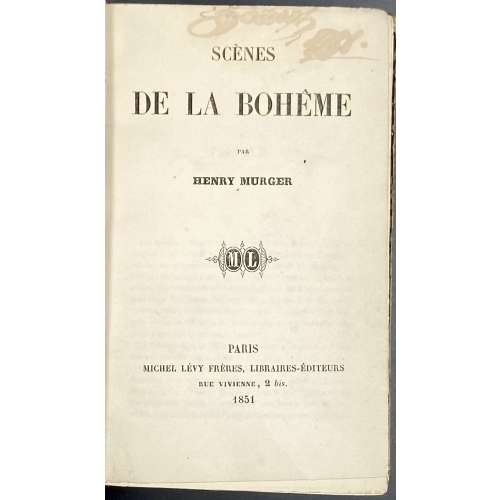 Hardcover volume, 18.2 x 11.8 cm, bound in quarter black polished calf with gilt lettering “cartonnage romantique” design to spine, marbled boards, matching marbled endpapers, blue margins. Title-page: SCÈNES | DE LA BOHÊME | PAR | HENRY MURGER | {publisher’s device ML} | PARIS | MICHEL LÉVY FRÈRES, LIBRAIRES-ÉDITEURS | RUE VIVIENNE, 2 bis. | 1851 || Half-title: ŒUVRES | D’HENRY MURGER || Advertisement: Chez le même Éditeurs. | BIBLIOTHEQUE CONTEMPORAINE | (page of text) || Collation: π2 (h.t/advert., t.p. / blank), 1-33 (17)12, χ6; total 212 leaves without ffls (3 front, 2 back). Pagination: [2] – h.t. / blank, [2] – t.p. / blank, [i] ii-xiii [xiv blank], [1] 2-406; total 424 pages. Scènes de la bohême, in later editions Scènes de la vie de bohème. Translations: Into English: LIB-2719.2021. Henri Murger. The Bohemians of the Latin Quarter. (Scènes de la vie de Bohême) / Translated from the French. — London: Vizetelly & Co., 1883. Into German: LIB-2686.2021. Henri Murger. Die Bohème : Szenen aus dem Pariser Künstlerleben. — Leipzig: Insel-Verlag, 1906. Into Russian: LIB-3182.2023. А. Мюрже. Сцены из жизни богемы / Пер. с франц. и прим. Е. А. Гунста; вст. ст. С. И. Великовского; художник Н. А. Кравченко. — М.: Художественная литература, 1963. Contributors: Murger, Henri [Henry] (French, 1822 – 1861) – author.
Hardcover volume, 18.2 x 11.8 cm, bound in quarter black polished calf with gilt lettering “cartonnage romantique” design to spine, marbled boards, matching marbled endpapers, blue margins. Title-page: SCÈNES | DE LA BOHÊME | PAR | HENRY MURGER | {publisher’s device ML} | PARIS | MICHEL LÉVY FRÈRES, LIBRAIRES-ÉDITEURS | RUE VIVIENNE, 2 bis. | 1851 || Half-title: ŒUVRES | D’HENRY MURGER || Advertisement: Chez le même Éditeurs. | BIBLIOTHEQUE CONTEMPORAINE | (page of text) || Collation: π2 (h.t/advert., t.p. / blank), 1-33 (17)12, χ6; total 212 leaves without ffls (3 front, 2 back). Pagination: [2] – h.t. / blank, [2] – t.p. / blank, [i] ii-xiii [xiv blank], [1] 2-406; total 424 pages. Scènes de la bohême, in later editions Scènes de la vie de bohème. Translations: Into English: LIB-2719.2021. Henri Murger. The Bohemians of the Latin Quarter. (Scènes de la vie de Bohême) / Translated from the French. — London: Vizetelly & Co., 1883. Into German: LIB-2686.2021. Henri Murger. Die Bohème : Szenen aus dem Pariser Künstlerleben. — Leipzig: Insel-Verlag, 1906. Into Russian: LIB-3182.2023. А. Мюрже. Сцены из жизни богемы / Пер. с франц. и прим. Е. А. Гунста; вст. ст. С. И. Великовского; художник Н. А. Кравченко. — М.: Художественная литература, 1963. Contributors: Murger, Henri [Henry] (French, 1822 – 1861) – author. -
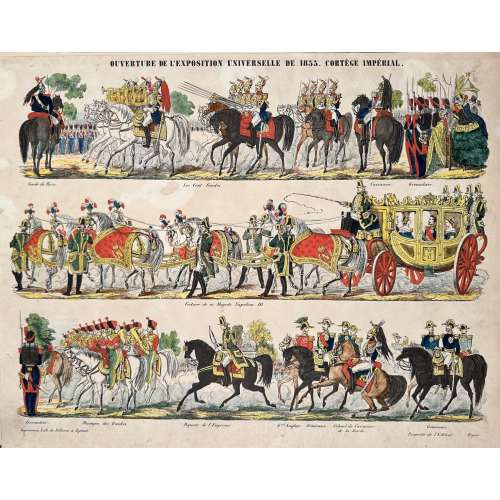 Hand-coloured woodcut on wove paper, 366 x 460 mm; black ink stamp “5057” to reverse. Caption cartoon in 2 tiers. Top: OUVERTURE DE 'EXPOSITION UNIVERSELLE DE 1855. CORTÈGE IMPÉRIAL. Captions top to bottom: Garde de Paris. — Les Cent Gardes. — Cuirassier. — Grenadiers. Middle: Voiture de sa Majesté Napoléon III. | Bottom: Grenadier. — Musique des Guides. — Piqueur de l’Empereur. — Gral Anglais — Généraux — Colonel de Cuirassiers | de la Garde — Généraux. Below left: Imprimerie Lith. de Pellerin, à Épinal; right: Propriété de l’Éditeur. Déposé. Jean Charles Pellerin (French, 1756 – 1836) – printer/publisher.
Hand-coloured woodcut on wove paper, 366 x 460 mm; black ink stamp “5057” to reverse. Caption cartoon in 2 tiers. Top: OUVERTURE DE 'EXPOSITION UNIVERSELLE DE 1855. CORTÈGE IMPÉRIAL. Captions top to bottom: Garde de Paris. — Les Cent Gardes. — Cuirassier. — Grenadiers. Middle: Voiture de sa Majesté Napoléon III. | Bottom: Grenadier. — Musique des Guides. — Piqueur de l’Empereur. — Gral Anglais — Généraux — Colonel de Cuirassiers | de la Garde — Généraux. Below left: Imprimerie Lith. de Pellerin, à Épinal; right: Propriété de l’Éditeur. Déposé. Jean Charles Pellerin (French, 1756 – 1836) – printer/publisher. -
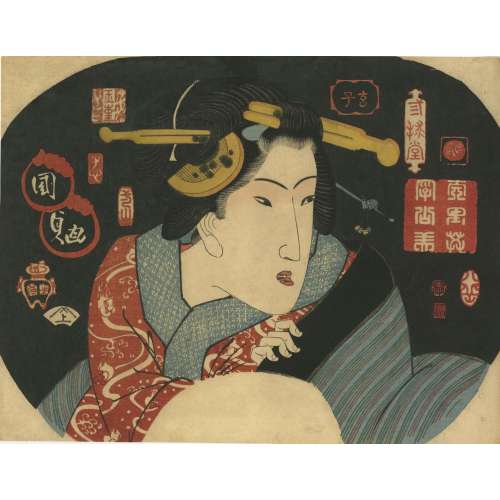 Artist: Utagawa Kunisada [歌川 国貞] a.k.a. Utagawa Toyokuni III [三代歌川豊国] (Japanese, 1786 – 1865). Publisher: Iseya Sōemon [伊勢屋惣右衛門] (Japanese, c. 1776 – 1862). Signed: Kunisada ga within a double toshidama. Date-kiwame seals: Bunsei 11 (1828).
Artist: Utagawa Kunisada [歌川 国貞] a.k.a. Utagawa Toyokuni III [三代歌川豊国] (Japanese, 1786 – 1865). Publisher: Iseya Sōemon [伊勢屋惣右衛門] (Japanese, c. 1776 – 1862). Signed: Kunisada ga within a double toshidama. Date-kiwame seals: Bunsei 11 (1828). -
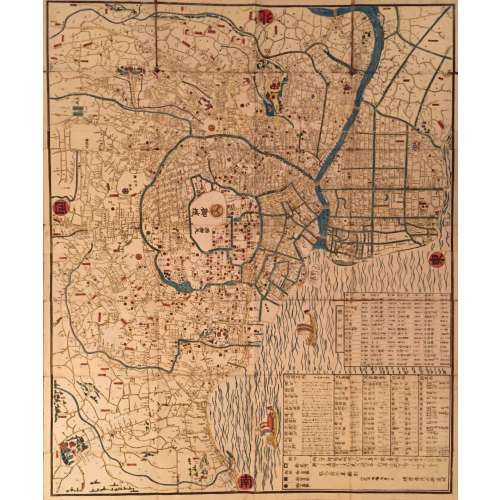
-
 Utagawa Kunisada [歌川 国貞] a.k.a. Utagawa Toyokuni III [三代歌川豊国] (Japanese, 1786 – 1865)
Utagawa Kunisada [歌川 国貞] a.k.a. Utagawa Toyokuni III [三代歌川豊国] (Japanese, 1786 – 1865)Promotional fan for a hairpin shop, with a poem by Ichikawa Danjuro VII, signed Hakuen.
Date seal plus rectangular kiwame seal: Bunsei 8 (1825).
Size: Fan print. Uchiwa-e (27.5 x 21.1 cm) Publisher seal: Maru-To (2) (Marks U204). Date seal plus rectangular kiwame seal: Bunsei 8 (1825). -
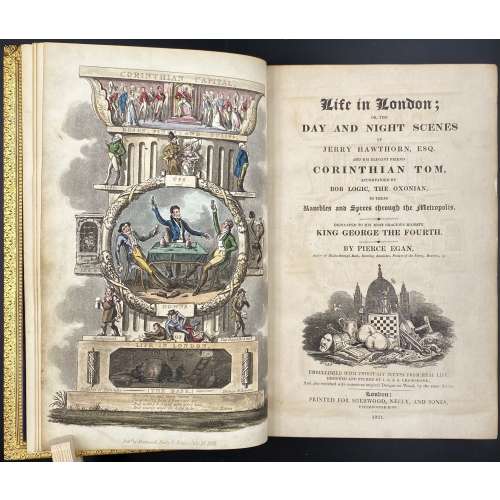
Title: Life in London ; | DAY AND NIGHT SCENES | OF | JERRY HAWTHORN, ESQ. | AND HIS ELEGANT FRIEND | CORINTHIAN TOM, | ACCOMPANIED BY | BOB LOGIC, THE OXONIAN, | IN THEIR |Rambles and Sprees through the Metropolis. | DEDICATED TO HIS MOST GRACIOUS MAJESTY | KING GEORGE THE FOURTH. | BY PIERCE EGAN, | Author of Walks through Bath, Sporting Anecdotes, Picture of the Fancy, Boxiana, &c. | [Vignette] | EMBELLISHED WITH THIRTY-SIX SCENES FROM REAL LIFE, | DESIGNED AND ETCHED BY I. R. & G. CRUIKSHANK ; | And also enriched with numerous original Designs on Wood, by the same Artists, | London: | PRINTED FOR SHERWOOD, NEELY, AND JONES, | PATERNOSTER-ROW. | 1821. ||
Edition: 1st edition, 1st issue: the first sheet of music is not numbered, absence of any footnote at page 9 (as per Cohn).
Pagination: 3 binder's flyleaves with a specimen of George Cruikshank's signature of Nov. 5th, 1860 to the first one; hand-coloured aquatint frontispiece facing the title page with blank recto, [iii-iv] – t.p. with vignette/ blank, [v] vi-viii – dedication, ix-xii – contents, [xiii]-xvi – list of illustrations; [1] 2-376; 35 hand-coloured aquatints, 3 folding leaves of music; bound without half-title [missing pp. i, ii], advertisements or 'to the subscribers' leaf.
Collation: 8vo; [A]7 B-Z8 Aa8-Bb4.
Binding: Full polished calf gilt by Rivière & Son, covers with triple gilt border, spine in 6 compartments, brown morocco lettering pieces to second and third, others richly gilt, raised bands, all edges gilt; neatly re-backed preserving spine.
Catalogue raisonné: Albert M. Cohn, 1924: № 262 p. 90; Abbey, J. R. (Life in England), 281; Tooley (Some English Books with Coloured Plates) 196; Prideaux (Aquatint Engraving) pp. 307, 310; Hardie (English coloured books) 197.
Description of Shapero Rare Books, London: There was a translation into French. At least six plays were based on Egan's characters, contributing to yet more sales. One of these was exported to America, launching the Tom and Jerry craze there. The version created by William Thomas Moncrieff was praised as The Beggar's Opera of its day. Moncrieff's production of Tom and Jerry, or Life in London ran continuously at the Adelphi Theatre for two seasons and it was the dramatist's work as much as the author's that did so much to popularise the book's trademark use of fashionable slang. In 1821 Egan announced the publication of a regular journal: Life in London, appearing monthly at a shilling a time. It was to be illustrated by George Cruikshank (1792 – 1878), and was dedicated to the King, George IV, who at one time had received Egan at court. The first edition of Life in London appeared on 15 July 1821. Egan's creation was an instant success. Pirate versions appeared, featuring such figures as 'Bob Tallyho', 'Dick Wildfire' and the like. Printmakers speedily knocked off cuts featuring the various 'stars' and the real-life public flocked to the 'sporting' addresses that Egan had his heroes frequent. -
 Artist: Utagawa Kunisada [歌川 国貞], a.k.a. Utagawa Toyokuni III [三代 歌川 豊国] (Japanese, 1786 – 1865). Signed: Toyokuni ga [豊国 画] in a red toshidama cartouche Block carver: Yokokawa Takejirō [横川竹二郎] (Japanese, fl. 1845 – 1863), seal: 彫竹 – hori Take. Publisher: Ibaya Senzaburō [伊場屋仙三郎] (Japanese, fl. c. 1845 – 1847). Media: Untrimmed fan print (uchiwa-e), 232 x 300 mm. Title: Tamagiku [玉菜]. Series: Chronicles of Elegant Women [風雅女史傳] (Fūga joshiden). Combined date seal and kiwame censor seal: Ansei 6 (1859). Other prints from the same series in this collection [SVJP-0216.2016] — Princess Sotoori:
Artist: Utagawa Kunisada [歌川 国貞], a.k.a. Utagawa Toyokuni III [三代 歌川 豊国] (Japanese, 1786 – 1865). Signed: Toyokuni ga [豊国 画] in a red toshidama cartouche Block carver: Yokokawa Takejirō [横川竹二郎] (Japanese, fl. 1845 – 1863), seal: 彫竹 – hori Take. Publisher: Ibaya Senzaburō [伊場屋仙三郎] (Japanese, fl. c. 1845 – 1847). Media: Untrimmed fan print (uchiwa-e), 232 x 300 mm. Title: Tamagiku [玉菜]. Series: Chronicles of Elegant Women [風雅女史傳] (Fūga joshiden). Combined date seal and kiwame censor seal: Ansei 6 (1859). Other prints from the same series in this collection [SVJP-0216.2016] — Princess Sotoori: SVJP-0400.2023 — Saiko:
SVJP-0400.2023 — Saiko:
 Note by Elena Varshavsky:
Tamagiku [玉菜] (Japanese, 1702 – 1726) – Precious Chrysanthemum (translated also as Jade Chrysanthemum; one can say also Gem Chrysanthemum). She was a courtesan famous for her beauty, kind heart, and countless artistic accomplishments. She died young and was deeply grieved by the establishment of Nakamanji-ya (中万字屋) for which she worked, and beyond. Her memory was celebrated during the Bon festival of the commemoration of the dead, and lanterns were hung at the gallery of that establishment and other neighbouring ones to commemorate her and appease her soul. These lanterns are seen behind her. Kabuki plays were continuously dedicated to her, she figured in Edo period literature and was often portrayed on ukiyo-e prints. In many cases, she was shown with the lanterns associated with her. Those lanterns were called “Tamagiku Lanterns”.
Other depictions of Tamagiku:
Note by Elena Varshavsky:
Tamagiku [玉菜] (Japanese, 1702 – 1726) – Precious Chrysanthemum (translated also as Jade Chrysanthemum; one can say also Gem Chrysanthemum). She was a courtesan famous for her beauty, kind heart, and countless artistic accomplishments. She died young and was deeply grieved by the establishment of Nakamanji-ya (中万字屋) for which she worked, and beyond. Her memory was celebrated during the Bon festival of the commemoration of the dead, and lanterns were hung at the gallery of that establishment and other neighbouring ones to commemorate her and appease her soul. These lanterns are seen behind her. Kabuki plays were continuously dedicated to her, she figured in Edo period literature and was often portrayed on ukiyo-e prints. In many cases, she was shown with the lanterns associated with her. Those lanterns were called “Tamagiku Lanterns”.
Other depictions of Tamagiku:

Tamagiku (Ancient and modern women's biography) by Kunisada, 1859.

Courtesan Tamagiku by Kunichika.

Tamagiku of the Nakamanjiya, Inaki Shinnojō, and Nakamanjiya Yahei (looking through the window) by Kunisada.

Nakamanji-Ya Tamagiku by Kunisada
Sources: darumapedia; kajiipeta; kabuki21; crosseyedgallery.
Nakamanji-Ya Tamagiku by Kunisada, 1857
-
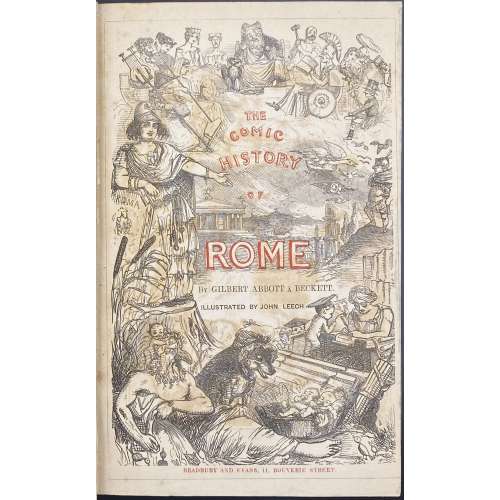 Woodcut pictorial title page (red and black): THE | COMIC | HISTORY | OF | ROME | By GILBERT ABBOTT À BECKETT. | ILLUSTRATED BY JOHN LEECH. | BRADBURY AND EVANS, 11, BOUVERIE STREET. || Pagination: [iii-iv] – t.p. / imprint., [v]-vi – preface, [vii]-viii – contents, [ix]-xii – list of ills., [1] 2-308, lacking half-title (i-ii) otherwise as called for by Tooley (1935) p. 162. Collation: π1 b4 B-U8 X2 plus 10 plates, incl. frontispiece, of hand-coloured steel engravings and 98 in-text woodcuts by John Leech. Imprint: “LONDON: | BRADBURY AND EVANS, PRINTERS, WHITEFRIARS.”; same in the colophon on p. 308, in one line. Binding: 22 x 14.5 cm, full tan calf with gilt double-fillet border, spine gilt in compartments with red morocco label lettered in gilt, blind-stamped dentelle inside, marbled endpapers, additional flyleaf at the end (binding similar to 2-volume “The Comic History of England” LIB-2847.2021, making three volumes in total). Edition: 1st thus (in book form), without “and Co.” in the imprint on t.p. verso. Catalogue raisonné: Tooley (1935) p. 162. Catalogue raisonné: Hardie p. 210; Abbey, Life № 435, p. 365-6; Tooley (1935) p. 162. Contributors: Gilbert Abbott à Beckett (British, 1811 – 1856) – author. John Leech (British, 1817 – 1864) – artist. Bradbury & Evans (Whitefriars); William Bradbury (British, 1799 – 1869); Frederick Mullett Evans (British, 1804 – 1870) – printer.
Woodcut pictorial title page (red and black): THE | COMIC | HISTORY | OF | ROME | By GILBERT ABBOTT À BECKETT. | ILLUSTRATED BY JOHN LEECH. | BRADBURY AND EVANS, 11, BOUVERIE STREET. || Pagination: [iii-iv] – t.p. / imprint., [v]-vi – preface, [vii]-viii – contents, [ix]-xii – list of ills., [1] 2-308, lacking half-title (i-ii) otherwise as called for by Tooley (1935) p. 162. Collation: π1 b4 B-U8 X2 plus 10 plates, incl. frontispiece, of hand-coloured steel engravings and 98 in-text woodcuts by John Leech. Imprint: “LONDON: | BRADBURY AND EVANS, PRINTERS, WHITEFRIARS.”; same in the colophon on p. 308, in one line. Binding: 22 x 14.5 cm, full tan calf with gilt double-fillet border, spine gilt in compartments with red morocco label lettered in gilt, blind-stamped dentelle inside, marbled endpapers, additional flyleaf at the end (binding similar to 2-volume “The Comic History of England” LIB-2847.2021, making three volumes in total). Edition: 1st thus (in book form), without “and Co.” in the imprint on t.p. verso. Catalogue raisonné: Tooley (1935) p. 162. Catalogue raisonné: Hardie p. 210; Abbey, Life № 435, p. 365-6; Tooley (1935) p. 162. Contributors: Gilbert Abbott à Beckett (British, 1811 – 1856) – author. John Leech (British, 1817 – 1864) – artist. Bradbury & Evans (Whitefriars); William Bradbury (British, 1799 – 1869); Frederick Mullett Evans (British, 1804 – 1870) – printer. -
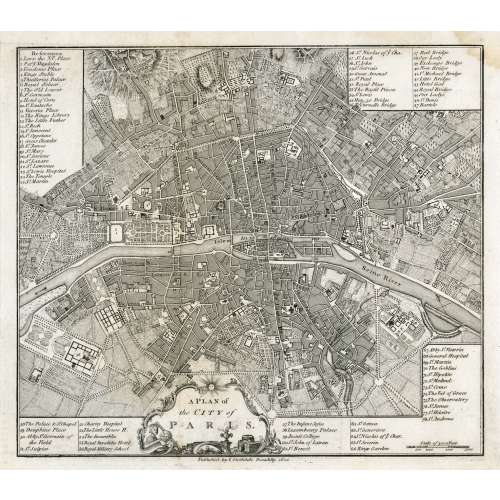 In pictorial frame: A PLAN of | the CITY of PARIS. || Under the border: Published by I. Stockdale Piccadilly 1800 || Dimensions: Sheet: 29 x 34.5 cm; Image: 22.7 x 25.9 cm.
In pictorial frame: A PLAN of | the CITY of PARIS. || Under the border: Published by I. Stockdale Piccadilly 1800 || Dimensions: Sheet: 29 x 34.5 cm; Image: 22.7 x 25.9 cm. -
 The central sheet of (optional) triptych: Courtesan (Tayū): kabuki actor Bandō Mitsugorō III as Fujiya Izaemon from Three pleasures of present-day Osaka (Tōsei Naniwa no sankō)「当世浪花の三興 太夫」 「藤屋伊左衛門」 三代目坂東三津五郎. Publisher: Iseya Rihei [伊勢屋利兵衛] (Japanese, fl. 1790s – c. 1879) Year: 1821 (Bunsei 4). Size: Vertical ōban; 36.5 x 25.1 cm. Signed: 於浮瀬亭国貞画 – Drawn by Kunisada in Ukabuse (Ukabuse ni oite Kunisada ga). Ukabuse is the name of a famous restaurant in Osaka, this signature can be found only on a three print bijin series [Kunisada Project]. Censor's seal: kiwame 改印:極 Actor Bandō Mitsugorō III [三代目 坂東 三津五郎] (Japanese, 1775 – 1831); other names: Bandō Minosuke I, Morita Kanjirô II, Bandō Mitahachi I, Bandō Minosuke I, Bandō Mitahachi I. Character: Fujiya Izaemon. Ref: MFA ACCESSION NUMBER 11.21937; LIB-2967.2022 Izzard. Full series (triptych) Three Pleasures of Present-day Osaka (Tōsei Naniwa no sankō):
The central sheet of (optional) triptych: Courtesan (Tayū): kabuki actor Bandō Mitsugorō III as Fujiya Izaemon from Three pleasures of present-day Osaka (Tōsei Naniwa no sankō)「当世浪花の三興 太夫」 「藤屋伊左衛門」 三代目坂東三津五郎. Publisher: Iseya Rihei [伊勢屋利兵衛] (Japanese, fl. 1790s – c. 1879) Year: 1821 (Bunsei 4). Size: Vertical ōban; 36.5 x 25.1 cm. Signed: 於浮瀬亭国貞画 – Drawn by Kunisada in Ukabuse (Ukabuse ni oite Kunisada ga). Ukabuse is the name of a famous restaurant in Osaka, this signature can be found only on a three print bijin series [Kunisada Project]. Censor's seal: kiwame 改印:極 Actor Bandō Mitsugorō III [三代目 坂東 三津五郎] (Japanese, 1775 – 1831); other names: Bandō Minosuke I, Morita Kanjirô II, Bandō Mitahachi I, Bandō Minosuke I, Bandō Mitahachi I. Character: Fujiya Izaemon. Ref: MFA ACCESSION NUMBER 11.21937; LIB-2967.2022 Izzard. Full series (triptych) Three Pleasures of Present-day Osaka (Tōsei Naniwa no sankō):


-
 Series: Pictures Associated with the Iroha Syllabary [伊呂波画合]. Artist: Utagawa Kuniyoshi [歌川 國芳] (1798 – 1861). Signed: Ichiyûsai Kuniyoshi giga [一勇斎 國芳戯画] (Playfully drawn by Ichiyūsai Kuniyoshi) in a red double-gourd cartouche with a kiri-mon seal beneath. Publisher: Iseya Ichiemon [伊勢屋市右衛門] (Japanese, fl. 1823 – c. 1864); seal [辻] (Marks 16-029 | 143a). Single nanushi censor seal: Mura [村] = Murata Sahei [村田佐右衛] (VI/1842 – V/1846). Media: Fan print (uchiwa-e, 団扇絵), 231 x 296 mm. Theme: The Treasury of Loyal Retainers [仮名手本忠臣蔵] (Kanadehon Chūshingura) – an 11-act puppet play composed in 1748, based on a historical event. "Most historians now agree that there were forty-seven rōnin of Ako who attacked and killed Kira Yoshinaka (吉良 義央, 1641 – 1703) in Edo in the twelfth month of 1702, twenty-two months after their lord Asano Naganori (浅野 長矩, 1667 – 1701) had been put to death for his own failed attempt on Kira’s life". [Henry D. SMITH II. The Trouble with Terasaka: The Forty-Seventh Rōnin and the Chūshingura Imagination / Japan Review, 2004, 16:3-65]. The reader shall remember that the fictional, romantic version of the Akō incident [赤穂事件] (Akō jiken) may not (and most probably does not) reflect the historical truth of events. Uncut fan print depicting a beautiful young woman covering another woman's mouth with a blue striped cloth, possibly an obi. The picture on the wall represents the scene from the final act of The Treasury of Loyal Retainers (Kanadehon Chūshingura, Act 11) when 47 loyal retainers (rōnin) of the late lord En'ya Hangan came to the house of Kō no Moronao in order to avenge their dead master. The leader of 47 rōnin, Ōboshi Yuranosuke, divided his accomplices into several groups which attacked the Moronao mansion from different directions. To coordinate the attack and keep communication among the groups, the rōnin were signing the first syllables of their names in the hiragana syllabary. There are two major types of the ordering of the hiragana syllabary, the Gojūon one and the Iroha order (pangram poem), the latter being used here. The number of avengers exactly matches the 47 letters of that syllabary. The group entering Moronao's house from the front gate was 'chi-ri-nu-ru-wo-wa-ka'. Yoshida Sadaemon Kanesada [葦田貞右衛門兼貞] (1675 – 1703) depicted on this fan print belongs to this group. The character on the lantern hanging from Yoshida's spear reads Chū [忠] – for Chūshingura. Alternating black and white triangles on the picture frame allude to the 'signature' 47 ronin's uniform. This motif is usually described as a zigzag pattern [雁木模様] (gangi moyō), a mountain-shaped pattern [山形模様] (yamagata moyō), or a mountain road [山道] (yamamichi). The rōnin were allegedly wearing this uniform in imitation of firefighters. The government allowed the firefighters alone to gather in large groups and carry equipment akin to that of the military. Such equipment was necessary for firemen to tear down the burning buildings to stop the flames. The design can be seen in Kunimaru's fan print [SVJP-0233.2018] in this collection.Fighting Moronao's guards, the 47 rōnin entered the mansion and searched for their enemy but in vain. Finally, Yazama Jujiro Motooki [矢間重次郎元興] found the villain in the charcoal chamber and called his friends. This is the exact moment we see in the picture on the wall: Yoshida entering the charcoal chamber with a spear in his hand amid falling baskets and charcoal. Kō no Moronao was brought to justice and beheaded; his head was offered before the memorial tablet of En'ya Hangan to appease his spirit. After that, Ōboshi Yuranosuke and his 46 friends committed seppuku. They were buried at Sengakuji (泉岳寺) – a small temple near Shinagawa in Edo (Tokyo).
Series: Pictures Associated with the Iroha Syllabary [伊呂波画合]. Artist: Utagawa Kuniyoshi [歌川 國芳] (1798 – 1861). Signed: Ichiyûsai Kuniyoshi giga [一勇斎 國芳戯画] (Playfully drawn by Ichiyūsai Kuniyoshi) in a red double-gourd cartouche with a kiri-mon seal beneath. Publisher: Iseya Ichiemon [伊勢屋市右衛門] (Japanese, fl. 1823 – c. 1864); seal [辻] (Marks 16-029 | 143a). Single nanushi censor seal: Mura [村] = Murata Sahei [村田佐右衛] (VI/1842 – V/1846). Media: Fan print (uchiwa-e, 団扇絵), 231 x 296 mm. Theme: The Treasury of Loyal Retainers [仮名手本忠臣蔵] (Kanadehon Chūshingura) – an 11-act puppet play composed in 1748, based on a historical event. "Most historians now agree that there were forty-seven rōnin of Ako who attacked and killed Kira Yoshinaka (吉良 義央, 1641 – 1703) in Edo in the twelfth month of 1702, twenty-two months after their lord Asano Naganori (浅野 長矩, 1667 – 1701) had been put to death for his own failed attempt on Kira’s life". [Henry D. SMITH II. The Trouble with Terasaka: The Forty-Seventh Rōnin and the Chūshingura Imagination / Japan Review, 2004, 16:3-65]. The reader shall remember that the fictional, romantic version of the Akō incident [赤穂事件] (Akō jiken) may not (and most probably does not) reflect the historical truth of events. Uncut fan print depicting a beautiful young woman covering another woman's mouth with a blue striped cloth, possibly an obi. The picture on the wall represents the scene from the final act of The Treasury of Loyal Retainers (Kanadehon Chūshingura, Act 11) when 47 loyal retainers (rōnin) of the late lord En'ya Hangan came to the house of Kō no Moronao in order to avenge their dead master. The leader of 47 rōnin, Ōboshi Yuranosuke, divided his accomplices into several groups which attacked the Moronao mansion from different directions. To coordinate the attack and keep communication among the groups, the rōnin were signing the first syllables of their names in the hiragana syllabary. There are two major types of the ordering of the hiragana syllabary, the Gojūon one and the Iroha order (pangram poem), the latter being used here. The number of avengers exactly matches the 47 letters of that syllabary. The group entering Moronao's house from the front gate was 'chi-ri-nu-ru-wo-wa-ka'. Yoshida Sadaemon Kanesada [葦田貞右衛門兼貞] (1675 – 1703) depicted on this fan print belongs to this group. The character on the lantern hanging from Yoshida's spear reads Chū [忠] – for Chūshingura. Alternating black and white triangles on the picture frame allude to the 'signature' 47 ronin's uniform. This motif is usually described as a zigzag pattern [雁木模様] (gangi moyō), a mountain-shaped pattern [山形模様] (yamagata moyō), or a mountain road [山道] (yamamichi). The rōnin were allegedly wearing this uniform in imitation of firefighters. The government allowed the firefighters alone to gather in large groups and carry equipment akin to that of the military. Such equipment was necessary for firemen to tear down the burning buildings to stop the flames. The design can be seen in Kunimaru's fan print [SVJP-0233.2018] in this collection.Fighting Moronao's guards, the 47 rōnin entered the mansion and searched for their enemy but in vain. Finally, Yazama Jujiro Motooki [矢間重次郎元興] found the villain in the charcoal chamber and called his friends. This is the exact moment we see in the picture on the wall: Yoshida entering the charcoal chamber with a spear in his hand amid falling baskets and charcoal. Kō no Moronao was brought to justice and beheaded; his head was offered before the memorial tablet of En'ya Hangan to appease his spirit. After that, Ōboshi Yuranosuke and his 46 friends committed seppuku. They were buried at Sengakuji (泉岳寺) – a small temple near Shinagawa in Edo (Tokyo).
Utagawa Kunimaru. Chūshingura, Act 11.
 Another fan print from the same series can be found at Kuniyoshi Project:
Another fan print from the same series can be found at Kuniyoshi Project:
 The same subject is portrayed by Kuniyoshi in the series Mirror of the True Loyalty of the Faithful Retainers [誠忠義臣鏡] (Seichû gishin kagami), publisher: Kagiya Hanjirô, c. 1851 (Kuniyoshi Project) – Yoshida Sadaemon Kanesada (葦田貞右衛門兼貞) raising his sword amid falling baskets and charcoal:
The same subject is portrayed by Kuniyoshi in the series Mirror of the True Loyalty of the Faithful Retainers [誠忠義臣鏡] (Seichû gishin kagami), publisher: Kagiya Hanjirô, c. 1851 (Kuniyoshi Project) – Yoshida Sadaemon Kanesada (葦田貞右衛門兼貞) raising his sword amid falling baskets and charcoal:

-
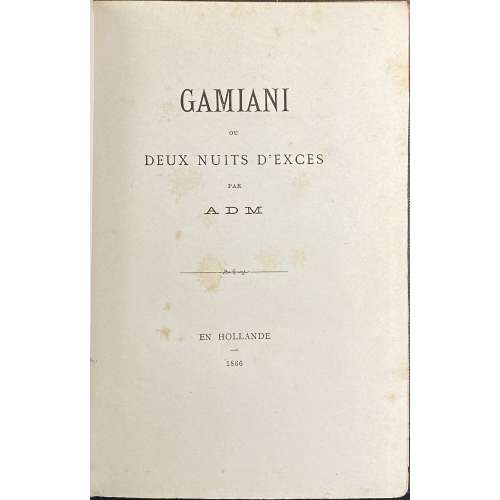 Single volume, 18 x 12.5 cm, bound in ¾ crimson morocco over marbled boards, gilt double-fillet borders, spine with gilded raised bands, gilt in compartments, gilt-lettered label, marbled endpapers, top margin gilt, text printed on dense wove paper, with 8 etchings by anonymous on thin laid paper (Chine) with tissue guards, after original lithographs by Devéria and Henri Grévedon or Octave Tassaert for the 1833 edition (1926 re-print LIB-3135.2023); the plate with the ape after 1864 edition (LIB-3087.2022) and the plate with the donkey after unknown. Title-page: GAMIANI | OU | DEUX NUITS D’EXCES | PAR | A D M | — | EN HOLLANDE | – | 1866 || Pagination: [4] (h.t., t.p.), [i] ii-xvi, [3] 4-153 [154 blank]; total 158 pages plus 8 plates (anonymous etchings), incl. frontispiece. Catalogue raisonné: Dutel I: A-470; Pia: 518/9. BNF Enfer 418. Note: This edition is conformant with Dutel, but not with Pia, who mentions [2], xvi, 148 pp. Pia writes: 'According to a bibliographic record published in 1874 by Vital Puissant, this edition was printed in Brussels by Briard on behalf of Alphonse Lécrivain, a Parisian publisher who took refuge in Belgium'. Catalogue Poulet-Malassis & ses amis description: № 74. [Alfred de MUSSET] A D M. Gamiani ou deux nuits d’excès. En Hollande, 1866. In-8 de xvi, 153 pages, demi-maroquin cerise à coins, dos à nerfs orné, lets dorés sur les mors, tête dorée, tranches naturelles, couverture conservée (reliure ancienne). Illustré de 8 gravures sur Chine dont l’une en frontispice, toutes accompagnées de serpentines. Piqûres et mouillures. Dutel A-470, pas à l’Enfer de la BnF.
Single volume, 18 x 12.5 cm, bound in ¾ crimson morocco over marbled boards, gilt double-fillet borders, spine with gilded raised bands, gilt in compartments, gilt-lettered label, marbled endpapers, top margin gilt, text printed on dense wove paper, with 8 etchings by anonymous on thin laid paper (Chine) with tissue guards, after original lithographs by Devéria and Henri Grévedon or Octave Tassaert for the 1833 edition (1926 re-print LIB-3135.2023); the plate with the ape after 1864 edition (LIB-3087.2022) and the plate with the donkey after unknown. Title-page: GAMIANI | OU | DEUX NUITS D’EXCES | PAR | A D M | — | EN HOLLANDE | – | 1866 || Pagination: [4] (h.t., t.p.), [i] ii-xvi, [3] 4-153 [154 blank]; total 158 pages plus 8 plates (anonymous etchings), incl. frontispiece. Catalogue raisonné: Dutel I: A-470; Pia: 518/9. BNF Enfer 418. Note: This edition is conformant with Dutel, but not with Pia, who mentions [2], xvi, 148 pp. Pia writes: 'According to a bibliographic record published in 1874 by Vital Puissant, this edition was printed in Brussels by Briard on behalf of Alphonse Lécrivain, a Parisian publisher who took refuge in Belgium'. Catalogue Poulet-Malassis & ses amis description: № 74. [Alfred de MUSSET] A D M. Gamiani ou deux nuits d’excès. En Hollande, 1866. In-8 de xvi, 153 pages, demi-maroquin cerise à coins, dos à nerfs orné, lets dorés sur les mors, tête dorée, tranches naturelles, couverture conservée (reliure ancienne). Illustré de 8 gravures sur Chine dont l’une en frontispice, toutes accompagnées de serpentines. Piqûres et mouillures. Dutel A-470, pas à l’Enfer de la BnF. -
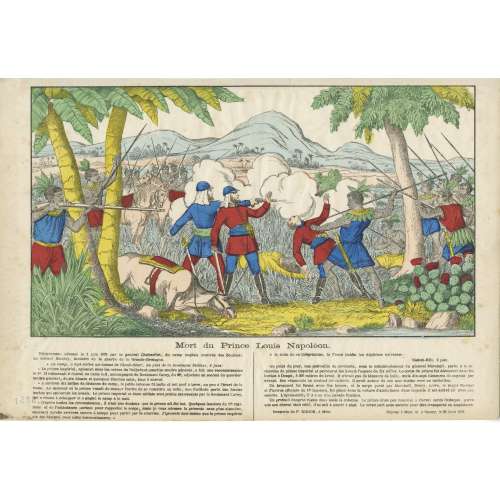 Hand-coloured woodcut on wove paper, 267 x 390 mm. On reverse: black ink stamp “5351”. Centre, under the image frame "Mort du Prince Louis Napoléon". Below left: "Télégramme adressé le 2 juin 1879 par le général Chelmsfort, du camp anglais (contrée des Zoulous), au colonel Stanley, ministre de la guerre de la Grande-Bretagne. « Au camp, à sept milles au-dessus de Blood-River, au pied de la montagne Stellezi, 2 juin: Le prince impérial, agissant sous les ordres de l'adjudant quartier-maitre général. a fait une reconnaissance le 1er. Il retournait à cheval au camp le 2 accompagné du lieutenant Carey, du 98e adjudant en second du quartier-maitre général. de six blancs et, quelques Zoulous amis, tous à cheval. A environ dix milles de distance du camp, la petite colonne fit halte at mit pied à terre, un peu à l’écart de la route. Au moment ou le prince venait de donner l'ordre de se remettre en selle. une fusillade partit des hautes herbes qui entourant les kraals. Le prince impérial et deux soldats sont portés manquants par le lieutenant Carey, qui a réussi à échapper et a gagné le camp à la nuit. D'après toutes les circonstances, il 'est pas douteux quo le prince ait été tué. Quelques lanciers du 17 régiment et de l'ambulance partent pour rapporter le corps; mais je vous adresse la présente sans plus attendre, espérant qu'elle arrivera encore à temps pour partir par le courrier. J’ignorais moi-même que le prince impérial eût été désigné pour cette reconnaissance. »" Below right: A la suite de le télégramme, le Times publie les dépêches suivantes: Stelezi-Hill, 2 juin. Au point du jour, une patrouille de cavalerie, sous le commandement du général Marshall. partit à la recherche du prince impérial et parcourut les kraals l'espace de dix milles. Le corps du prince fut découvert dans les herbes à Donga, à 300 mètres du kraal. Il n'avait pas de blessure de balle, mais dix-sept blessures de zagaies par devant. Ses vêtements lui avaient été enlevés. I avait autour du cou une chaine avec un médaillon. Un brancard fut formé avec les lances, et le corps porté par Marchall, Drury, Lowe, le mjor Stewart et d'autres officiers du 17e lanciers, fut. place dans la voiture d'ambulance dans laquelle il est arrivé ici avec une escorte. L'après-midi, il v a eu une parade funèbre. Un profond chagrin règne dans toute la colonne. Le prince n'est pas remonté à cheval après l’attique, parce que son cheval était rétif ; il se mit à courir à pied. Le corps part sous escorte pour être transporté en Angleterre. Bottom right: "Imagerie de P. DIDION, à Metz — Déposé à Metz et à Nancy, le 25 Juin 1879". Paulin Didion (French, 1831 – 1879) – publisher/printer.
Hand-coloured woodcut on wove paper, 267 x 390 mm. On reverse: black ink stamp “5351”. Centre, under the image frame "Mort du Prince Louis Napoléon". Below left: "Télégramme adressé le 2 juin 1879 par le général Chelmsfort, du camp anglais (contrée des Zoulous), au colonel Stanley, ministre de la guerre de la Grande-Bretagne. « Au camp, à sept milles au-dessus de Blood-River, au pied de la montagne Stellezi, 2 juin: Le prince impérial, agissant sous les ordres de l'adjudant quartier-maitre général. a fait une reconnaissance le 1er. Il retournait à cheval au camp le 2 accompagné du lieutenant Carey, du 98e adjudant en second du quartier-maitre général. de six blancs et, quelques Zoulous amis, tous à cheval. A environ dix milles de distance du camp, la petite colonne fit halte at mit pied à terre, un peu à l’écart de la route. Au moment ou le prince venait de donner l'ordre de se remettre en selle. une fusillade partit des hautes herbes qui entourant les kraals. Le prince impérial et deux soldats sont portés manquants par le lieutenant Carey, qui a réussi à échapper et a gagné le camp à la nuit. D'après toutes les circonstances, il 'est pas douteux quo le prince ait été tué. Quelques lanciers du 17 régiment et de l'ambulance partent pour rapporter le corps; mais je vous adresse la présente sans plus attendre, espérant qu'elle arrivera encore à temps pour partir par le courrier. J’ignorais moi-même que le prince impérial eût été désigné pour cette reconnaissance. »" Below right: A la suite de le télégramme, le Times publie les dépêches suivantes: Stelezi-Hill, 2 juin. Au point du jour, une patrouille de cavalerie, sous le commandement du général Marshall. partit à la recherche du prince impérial et parcourut les kraals l'espace de dix milles. Le corps du prince fut découvert dans les herbes à Donga, à 300 mètres du kraal. Il n'avait pas de blessure de balle, mais dix-sept blessures de zagaies par devant. Ses vêtements lui avaient été enlevés. I avait autour du cou une chaine avec un médaillon. Un brancard fut formé avec les lances, et le corps porté par Marchall, Drury, Lowe, le mjor Stewart et d'autres officiers du 17e lanciers, fut. place dans la voiture d'ambulance dans laquelle il est arrivé ici avec une escorte. L'après-midi, il v a eu une parade funèbre. Un profond chagrin règne dans toute la colonne. Le prince n'est pas remonté à cheval après l’attique, parce que son cheval était rétif ; il se mit à courir à pied. Le corps part sous escorte pour être transporté en Angleterre. Bottom right: "Imagerie de P. DIDION, à Metz — Déposé à Metz et à Nancy, le 25 Juin 1879". Paulin Didion (French, 1831 – 1879) – publisher/printer. -
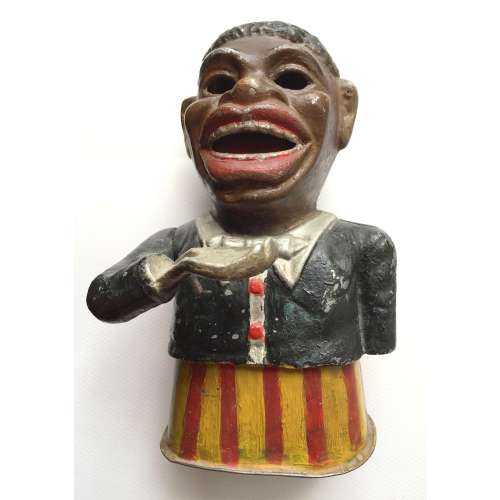 A cast iron painted 19th century style money box in the form of a negro, the arm articulated to insert coins.
A cast iron painted 19th century style money box in the form of a negro, the arm articulated to insert coins. -
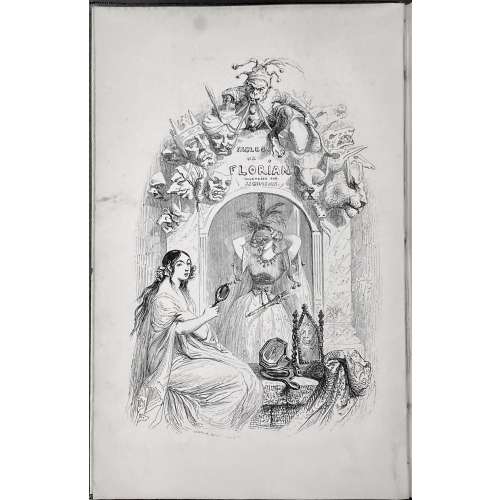 FABLES | DE FLORIAN | ILLUSTRÉES | PAR J.-J. GRANDVILLE , | SUIVIES | DE TOBIE ET RUTH , | Poëmes tirés de l'Ecriture Sainte | ET | PRECEDEES D'UNE NOTICE SUR LA VIE ET LES OUVRAGES DE FLORIAN , | PAR P.-J. STAHL. | [Vignette] PARIS. | J.-J. DUBOCHET ET Cie , ÉDITEURS , | 1842. Pagination: ffl, [2 blanks] [i, ii - ht/imp.] [2 - blank/engr. t.p. by Grandville] [iii, iv - t.p./blank] [v] vi-xx; 2 sheets of plates, [3] 4-292, bfl; engraved t.p. + [79] leaves of plates + 5 faux t.p. (total 85 plates) Size: In-8vo, 23.8 x 15 cm. Binding: Orig. blind-stamped navy cloth with gilt Grandville characters to boards and spine. First edition, first printing. Reference: Léopold Carteret (Le trésor du bibliophile. Epoque romantique. 1801-1875 / Livres illustrés du XIXe siècle. – Paris: L. Carteret; imprim. Lahure, 1927). Wood engravers: Adolphe Best (French, 1808 – 1860): 22 plates Louis-Henri Brévière (French, 1797 – 1869): 3 plates Brugnot (French, active 19th century): 7 plates Prosper-Adolphe-Léon Cherrier (French, born 1806): 6 + Tobie et Ruth + vignettes Louis Dujardin (French, 1808 – 1859): 2 plates Monogram GO–> (possibly for Godard) : 1 plate Halley-Hiback (French, 19th century): 1 + vignette Henri-Désiré Porret (French, 1800–1867): 2 + vignette Lacoste père et fils aîné et Auguste-Alexandre Guillaumot (French, 1815 – 1892): 5 plates Quichon (French, 19th century): 10 plates + Tobie et Ruth François Rouget (Belgian, born bef., 1825): 19 + vignette Unsigned or with an illegible signature: 6 plates
FABLES | DE FLORIAN | ILLUSTRÉES | PAR J.-J. GRANDVILLE , | SUIVIES | DE TOBIE ET RUTH , | Poëmes tirés de l'Ecriture Sainte | ET | PRECEDEES D'UNE NOTICE SUR LA VIE ET LES OUVRAGES DE FLORIAN , | PAR P.-J. STAHL. | [Vignette] PARIS. | J.-J. DUBOCHET ET Cie , ÉDITEURS , | 1842. Pagination: ffl, [2 blanks] [i, ii - ht/imp.] [2 - blank/engr. t.p. by Grandville] [iii, iv - t.p./blank] [v] vi-xx; 2 sheets of plates, [3] 4-292, bfl; engraved t.p. + [79] leaves of plates + 5 faux t.p. (total 85 plates) Size: In-8vo, 23.8 x 15 cm. Binding: Orig. blind-stamped navy cloth with gilt Grandville characters to boards and spine. First edition, first printing. Reference: Léopold Carteret (Le trésor du bibliophile. Epoque romantique. 1801-1875 / Livres illustrés du XIXe siècle. – Paris: L. Carteret; imprim. Lahure, 1927). Wood engravers: Adolphe Best (French, 1808 – 1860): 22 plates Louis-Henri Brévière (French, 1797 – 1869): 3 plates Brugnot (French, active 19th century): 7 plates Prosper-Adolphe-Léon Cherrier (French, born 1806): 6 + Tobie et Ruth + vignettes Louis Dujardin (French, 1808 – 1859): 2 plates Monogram GO–> (possibly for Godard) : 1 plate Halley-Hiback (French, 19th century): 1 + vignette Henri-Désiré Porret (French, 1800–1867): 2 + vignette Lacoste père et fils aîné et Auguste-Alexandre Guillaumot (French, 1815 – 1892): 5 plates Quichon (French, 19th century): 10 plates + Tobie et Ruth François Rouget (Belgian, born bef., 1825): 19 + vignette Unsigned or with an illegible signature: 6 plates -
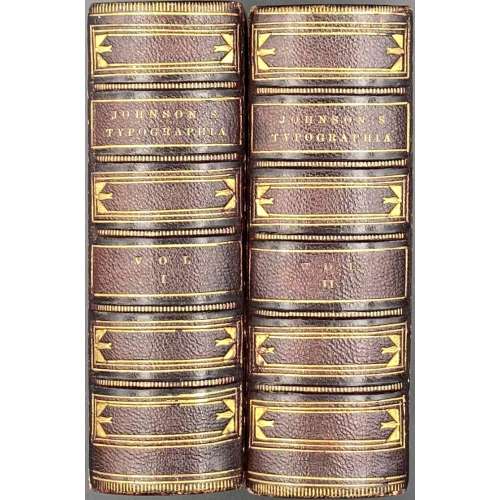 2 volume set, ¾ burgundy morocco over peacock marbled boards, ruled gilt, raised bands, gilt-ruled in compartments, gilt lettering, marbled endpapers and all margins, binding by W. S. Hiltz, NY. Vol. 1. Title: Typographia, | OR THE | Printers' Instructor: | INCLUDING AN ACCOUNT | of the | ORIGIN OF PRINTING, | with | Biographical Notices of the Printers of | England, from Caxton to the close | of the Sixteenth Century : | A Series of | Ancient and Modern Alphabets, | and | DOMESDAY CHARACTERS: | Together with | An Elucidation of every Subject con- | nected with the Art. | By J. JOHNSON, Printer. |{stanza}| Vol. I. | In frame: Published by Messrs. Longman, Hurst, | Rees, Orme, Brown & Green, Pater- | noster Row, London | Under the frame: 1824. || Pagination: Blank leaf, [2] – blank / engraved frontispiece (portrait of William Caxton by W. Hughes) w/guard, [2] – engraved t.p. by Thompson (upper margin almost none, tall lower margin, unframed) / blank, letterpress t.p. w/guard / blank, [2] – dedication to Earl Spenser and Roxburghe Club members / list of members, [2] – engraved Roxburgh Club plate by W. Hughes / blank, [4] – the pedigree of Earl Spenser, [i] ii-xii preface, [1] 2-610, [10] – index, blank leaf; printed on wove paper, text within double rule border. Vol. 2. Title: Typographia, | OR THE | Printers' Instructor: | INCLUDING AN ACCOUNT | of the | ORIGIN OF PRINTING, | with | Biographical Notices of the Printers of | England, from Caxton to the close | of the Sixteenth Century : | A Series of | Ancient and Modern Alphabets, | and | DOMESDAY CHARACTERS: | Together with | An Elucidation of every Subject con- | nected with the Art. | By J. JOHNSON, Printer. |{stanza}| Vol. II. | In frame: Published by Messrs. Longman, Hurst, | Rees, Orme, Brown & Green, Pater- | noster Row, London | Under the frame: 1824. || Pagination: Blank leaf, [2] – blank / engraved frontispiece (portrait of John Johnson ÆTATIS XLVI by William Harvey), w/o guard, [2] – engraved t.p. by G. W. Bonner (framed) / blank, letterpress t.p. w/o guard / blank, [2] – advert. / explanation of engraved title, [i]-iv contents, [1, 2] 3-663 [664], [14] – index, [2] – cantata, blank leaf; printed on wove paper, text within double rule border. Note: This is the book that served as a source of plagiarism for Adams's Typographia: a brief sketch of the origin, rise, and progress of the typographic art published in Philadelphia by himself in 1837.
2 volume set, ¾ burgundy morocco over peacock marbled boards, ruled gilt, raised bands, gilt-ruled in compartments, gilt lettering, marbled endpapers and all margins, binding by W. S. Hiltz, NY. Vol. 1. Title: Typographia, | OR THE | Printers' Instructor: | INCLUDING AN ACCOUNT | of the | ORIGIN OF PRINTING, | with | Biographical Notices of the Printers of | England, from Caxton to the close | of the Sixteenth Century : | A Series of | Ancient and Modern Alphabets, | and | DOMESDAY CHARACTERS: | Together with | An Elucidation of every Subject con- | nected with the Art. | By J. JOHNSON, Printer. |{stanza}| Vol. I. | In frame: Published by Messrs. Longman, Hurst, | Rees, Orme, Brown & Green, Pater- | noster Row, London | Under the frame: 1824. || Pagination: Blank leaf, [2] – blank / engraved frontispiece (portrait of William Caxton by W. Hughes) w/guard, [2] – engraved t.p. by Thompson (upper margin almost none, tall lower margin, unframed) / blank, letterpress t.p. w/guard / blank, [2] – dedication to Earl Spenser and Roxburghe Club members / list of members, [2] – engraved Roxburgh Club plate by W. Hughes / blank, [4] – the pedigree of Earl Spenser, [i] ii-xii preface, [1] 2-610, [10] – index, blank leaf; printed on wove paper, text within double rule border. Vol. 2. Title: Typographia, | OR THE | Printers' Instructor: | INCLUDING AN ACCOUNT | of the | ORIGIN OF PRINTING, | with | Biographical Notices of the Printers of | England, from Caxton to the close | of the Sixteenth Century : | A Series of | Ancient and Modern Alphabets, | and | DOMESDAY CHARACTERS: | Together with | An Elucidation of every Subject con- | nected with the Art. | By J. JOHNSON, Printer. |{stanza}| Vol. II. | In frame: Published by Messrs. Longman, Hurst, | Rees, Orme, Brown & Green, Pater- | noster Row, London | Under the frame: 1824. || Pagination: Blank leaf, [2] – blank / engraved frontispiece (portrait of John Johnson ÆTATIS XLVI by William Harvey), w/o guard, [2] – engraved t.p. by G. W. Bonner (framed) / blank, letterpress t.p. w/o guard / blank, [2] – advert. / explanation of engraved title, [i]-iv contents, [1, 2] 3-663 [664], [14] – index, [2] – cantata, blank leaf; printed on wove paper, text within double rule border. Note: This is the book that served as a source of plagiarism for Adams's Typographia: a brief sketch of the origin, rise, and progress of the typographic art published in Philadelphia by himself in 1837. -
![The Betrothed. From the Italian of Alessandro Manzoni. — London: Richard Bentley (successor to Henry Colburn). Cumming, Dublin; Bell & Bradfute, Edinburgh; Galignani, Paris, 1834. — Series: Standard novels, № XLIII [43]. The Betrothed. Complete in one volume.](https://varshavskycollection.com/wp-content/uploads/2021/02/LIB-1332-g-scaled-500x500.jpg) Half-title: STANDARD NOVELS. | № XLIII. | {6 lines of citation} | THE BETROTHED | COMPLETE IN ONE VOLUME. | LONDON: RICHARD BENTLEY | (SUCCESSOR TO HENRY COLBURN) : | BELL & BRADFUTE, EDINBURGH; | CUMMING, DUBLIN. | 1834 || Illustrated title page: THE BETROTHED, | FROM THE ITALIAN | OF | ALESSANDRO MANZONI. | {vignette by S. Smith after F. Pickering} | LONDON: | RICHARD BENTLEY | (SUCCESSOR TO HENRY COLBURN.) | CUMMING, DUBLIN, – BELL & BRADFUTE, EDINBURGH, | GALIGNANI, PARIS. |1834. || Title page: THE | BETROTHED. | FROM THE ITALIAN | OF | ALESSANDRO MANZONI. | LONDON: RICHARD BENTLEY, 8 NEW BURLINGTON STREET | (SUCCESSOR TO HENRY COLBURN): | BELL & BRADFUTE, EDINBURGH; | AND CUMMING, DUBLIN. | 1834 || Frontispiece: vignette by S. Smith after F. Pickering. Pagination: [i-v] 6-xii, [1] 2-452 [2 blank] + 2 plates. Collation: [A]6 B-Z8 AA-FF8 GG2 + 2 leaves of plates; Note: A1, A2, A4, GG2 – unsigned; both frontispiece and illustrated title are extraneous to collation. Binding: 2/3 black calf over marbled boards, raised bands w/gilt elements, gilt lettering in compartments and gilt title on a crimson label to spine; contemporary, but not the original publisher's binding; size: 16.5 x 10.5 cm Bookplates: Yellow sticker to front pastedown “J. K. Higgins, Northampton” (unknown); Ex libris to the front flyleaf: “Hilda Moore” (probably Hilda Mary Moore (British, 1886 – 1929) – a British stage and film actress. Series: Bentley's Standard Novels, № 43, first series. Catalogue raisonné: Michael Sadleir (1951): p. 101. Original title: ALESSANDRO MANZONI : I PROMESSI SPOSI Contributors: Manzoni, Alessandro (Italian, 1785 – 1873) Pickering, Ferdinand (British, 1810 – 1889) – artist. Smith, Samuel S. (British, 1810 – 1879) – engraver. A. Spottiswoode (London); Spottiswoode, Andrew (British, 1787 – 1866) – printer. Bentley, Richard (British, 1794 – 1871) – publisher. For the Russian edition see [LIB-1333.2017]: Алессандро Манцони. Обрученные. Повесть из истории Милана XVII века / Перевод И. И. Шитца. (Итальянская литература). — М.-Л.: Academia, 1936.
Half-title: STANDARD NOVELS. | № XLIII. | {6 lines of citation} | THE BETROTHED | COMPLETE IN ONE VOLUME. | LONDON: RICHARD BENTLEY | (SUCCESSOR TO HENRY COLBURN) : | BELL & BRADFUTE, EDINBURGH; | CUMMING, DUBLIN. | 1834 || Illustrated title page: THE BETROTHED, | FROM THE ITALIAN | OF | ALESSANDRO MANZONI. | {vignette by S. Smith after F. Pickering} | LONDON: | RICHARD BENTLEY | (SUCCESSOR TO HENRY COLBURN.) | CUMMING, DUBLIN, – BELL & BRADFUTE, EDINBURGH, | GALIGNANI, PARIS. |1834. || Title page: THE | BETROTHED. | FROM THE ITALIAN | OF | ALESSANDRO MANZONI. | LONDON: RICHARD BENTLEY, 8 NEW BURLINGTON STREET | (SUCCESSOR TO HENRY COLBURN): | BELL & BRADFUTE, EDINBURGH; | AND CUMMING, DUBLIN. | 1834 || Frontispiece: vignette by S. Smith after F. Pickering. Pagination: [i-v] 6-xii, [1] 2-452 [2 blank] + 2 plates. Collation: [A]6 B-Z8 AA-FF8 GG2 + 2 leaves of plates; Note: A1, A2, A4, GG2 – unsigned; both frontispiece and illustrated title are extraneous to collation. Binding: 2/3 black calf over marbled boards, raised bands w/gilt elements, gilt lettering in compartments and gilt title on a crimson label to spine; contemporary, but not the original publisher's binding; size: 16.5 x 10.5 cm Bookplates: Yellow sticker to front pastedown “J. K. Higgins, Northampton” (unknown); Ex libris to the front flyleaf: “Hilda Moore” (probably Hilda Mary Moore (British, 1886 – 1929) – a British stage and film actress. Series: Bentley's Standard Novels, № 43, first series. Catalogue raisonné: Michael Sadleir (1951): p. 101. Original title: ALESSANDRO MANZONI : I PROMESSI SPOSI Contributors: Manzoni, Alessandro (Italian, 1785 – 1873) Pickering, Ferdinand (British, 1810 – 1889) – artist. Smith, Samuel S. (British, 1810 – 1879) – engraver. A. Spottiswoode (London); Spottiswoode, Andrew (British, 1787 – 1866) – printer. Bentley, Richard (British, 1794 – 1871) – publisher. For the Russian edition see [LIB-1333.2017]: Алессандро Манцони. Обрученные. Повесть из истории Милана XVII века / Перевод И. И. Шитца. (Итальянская литература). — М.-Л.: Academia, 1936. -
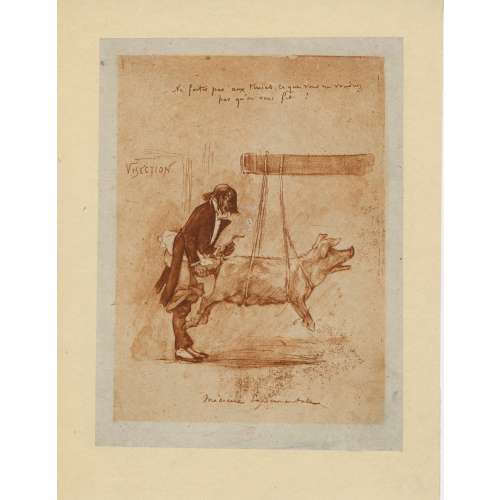
Sanguine print on toned China paper pasted on cream wove paper sheet, depicting a dressed-up man trying to copulate with a hanged sow. Inscription on top of the plate: "Ne faites pas aux truies ce que vous ne voudriez pas qu'on vous fit", and below: "Visection" (sic.). Owner's stamp 'LvM' on verso.
Dimensions: Paper: 26.8 x 20.6 cm; India paper: 21.5 x 16.2 cm; Image: 19.3 x 14.2 cm.
Catalogue raisonné: Arthur Hubschmid (1977): 661; Graphics irreverent and erotic (1968): 42.
-
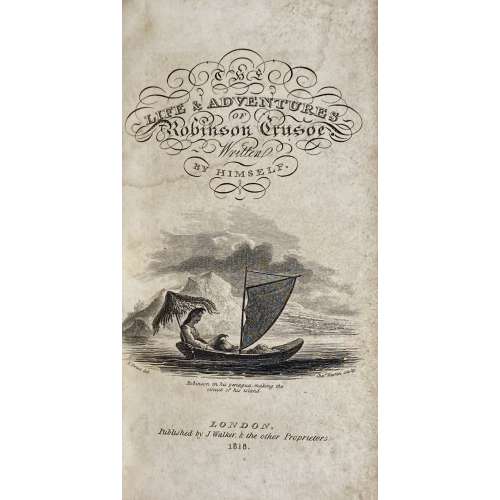 Description: 12mo, full calf, 12.9 x 7.4 cm, boards chain-bordered in gilt, front board gilt-lettered with the name of the owner “T. D. TOWNSEND”, flat spine, adorned in gilt, black label with gilt lettering, red endpapers, bookstore ticket to front pastedown: SOLD BY | ASH & MASON, | 139 Chesnut st.; ink ms inscription to ffep: Presented to | T. D. Townsend by | Mrs. Rebecca Cole of Burlington, N. Y. | Septr 29th 1827. Note: Ash & Mason bookstore and printing house in Philadelphia, PA. Engraved title-page: THE | LIFE & ADVENTURES | OF | Robinson Crusoe | Written | BY HIMSELF. | {vignette by C. Warren after T. Uwins, inscribed “Robinson on his periagua, making the circuit of his island”} | LONDON. | J. Walker & the other Proprietors | 1818. || Frontispiece: seated portrait of Robinson Crusoe in his bungalow with a dog and a cat by C. Warren after T. Uwins, inscribed below: ROBINSON CRUSOE | surrounded by his domestics || under the frame: T. Uwins del — C. Warren sculp.; beneath: London. Pub. by Walker & the other Proprietors || Title-page: THE | LIFE & ADVENTURES | OF | ROBINSON CRUSOE; | WRITTEN BY HIMSELF. | — | LONDON: | Printed for J. Walker; | 8 lines of names… and B. Reynolds. | 1818. || Collation: A6 (A1 torn out, A2 blank), B-Z12, 2A-2D12, 2E10 (2E8-10 blank); total 328 leaves plus two plates (engraved frontispiece and engraved title). Pagination: [2 torn out] [2 blank], [i-iii] iv-vi [2 blank] [1] 2-638 [6 blank]; total 656 pages, ill. Contributors: Daniel Defoe [Daniel De Foe] (British, 1660 – 1731) – author. Thomas Uwins (British, 1782 – 1857) – artist. Charles Warren (British, 1762 – 1823) – engraver. J Walker & Co. [Walker & Edwards] (London) – publisher. Ellerton and Henderson, Printers (London) – printer.
Description: 12mo, full calf, 12.9 x 7.4 cm, boards chain-bordered in gilt, front board gilt-lettered with the name of the owner “T. D. TOWNSEND”, flat spine, adorned in gilt, black label with gilt lettering, red endpapers, bookstore ticket to front pastedown: SOLD BY | ASH & MASON, | 139 Chesnut st.; ink ms inscription to ffep: Presented to | T. D. Townsend by | Mrs. Rebecca Cole of Burlington, N. Y. | Septr 29th 1827. Note: Ash & Mason bookstore and printing house in Philadelphia, PA. Engraved title-page: THE | LIFE & ADVENTURES | OF | Robinson Crusoe | Written | BY HIMSELF. | {vignette by C. Warren after T. Uwins, inscribed “Robinson on his periagua, making the circuit of his island”} | LONDON. | J. Walker & the other Proprietors | 1818. || Frontispiece: seated portrait of Robinson Crusoe in his bungalow with a dog and a cat by C. Warren after T. Uwins, inscribed below: ROBINSON CRUSOE | surrounded by his domestics || under the frame: T. Uwins del — C. Warren sculp.; beneath: London. Pub. by Walker & the other Proprietors || Title-page: THE | LIFE & ADVENTURES | OF | ROBINSON CRUSOE; | WRITTEN BY HIMSELF. | — | LONDON: | Printed for J. Walker; | 8 lines of names… and B. Reynolds. | 1818. || Collation: A6 (A1 torn out, A2 blank), B-Z12, 2A-2D12, 2E10 (2E8-10 blank); total 328 leaves plus two plates (engraved frontispiece and engraved title). Pagination: [2 torn out] [2 blank], [i-iii] iv-vi [2 blank] [1] 2-638 [6 blank]; total 656 pages, ill. Contributors: Daniel Defoe [Daniel De Foe] (British, 1660 – 1731) – author. Thomas Uwins (British, 1782 – 1857) – artist. Charles Warren (British, 1762 – 1823) – engraver. J Walker & Co. [Walker & Edwards] (London) – publisher. Ellerton and Henderson, Printers (London) – printer. -
 Artist: Utagawa Kuniyoshi [歌川 國芳] (Japanese, 1798 – 1861) Publisher: British Museum provides for the title as Enkyoku-zoroi [艶曲揃] (Set of Voluptuous Melodies) and the publisher as Sanpei. Indeed, 三平 (Sanpei) was a wholesale fan shop at the end of the Edo period. However, Andreas Marks identifies the publisher’s seal as 三平 Mihei = Mikawaya Heiroku (1848-56), a member of the Fan Producing Guild (AM 11-016|325a). Block carver: Hori Take [彫竹]
Artist: Utagawa Kuniyoshi [歌川 國芳] (Japanese, 1798 – 1861) Publisher: British Museum provides for the title as Enkyoku-zoroi [艶曲揃] (Set of Voluptuous Melodies) and the publisher as Sanpei. Indeed, 三平 (Sanpei) was a wholesale fan shop at the end of the Edo period. However, Andreas Marks identifies the publisher’s seal as 三平 Mihei = Mikawaya Heiroku (1848-56), a member of the Fan Producing Guild (AM 11-016|325a). Block carver: Hori Take [彫竹]Signed: Ichiyosai Kuniyoshi ga in a red cartouche and sealed with paulownia (kiri mon).
Date seal and double nanushi censor seals: Fuku & Muramatsu, 1853 (Kaei 6, 2nd month).
Size: Uchiwa-e (untrimmed fan print) 229 x 294 mm.
Provenance: The Collection of Paul F. Walter, Christie's, New York, 2017, lot 338; sold together with 10 other fan prints for $27,500. Before: Christie's, New York, 1994, lot 145 ($4,830). Ref: [LIB-1693.2018] The Collection of Paul Walter. — NY: Christie's, 2017, p. 361. Ref: Israel Goldman, Catalogue 2018, № 41: "Utagawa Kuniyoshi (1797-1861) A Woman on a Terrace Dancing with a Fan. From the series Enkyoku zoroi (Collection of Charming Music). 1853. Fan print. 22.9 x 29.4 cm. Provenance: Japanese Prints, Paintings and Screens, Christie's, New York, 1994, lot 145 ($4,830); The Collection of Paul F. Walter, Christie's, New York, 2017, lot 338. Fine impress." Known prints in this series:
SVJP-0251.2018
-
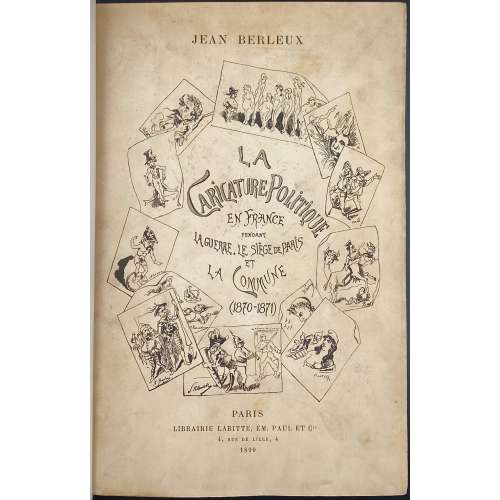 Hardcover, 25.2 x 17 cm, quarter burgundy shagreen with raised bands and gilt lettering to spine over turkish marbled boards and endpapers, publisher’s wrappers preserved. Title-page: JEAN BERLEUX | LA | CARICATURE POLITIQUE | EN FRANCE | PENDANT LA GUERRE, LE SIÈGE DE PARIS | ET LA COMMUNE | (1870–1871) | {vignette} | PARIS | LABITTE, ÉM. PAUL ET Cie | LIBRAIRES DE LA BIBLIOTHÈQUE NATIONALE | 4, RUE DE LILLE, 4 | – | 1890 || Collation: 4to; π8 1-274 282, plates within collation; total 118 leaves. Pagination: [i-ix] x-xvi, [1] 2-217 (printed 317) [3], total 236 pages, profusely illustrated, incl. in-text and full-page b/w ils, all within pagination. Condition: Good, scattering foxing, pencil marks. Contributors: Maurice Quentin-Bauchart [pseud. Jean Berleux] (French, 1857 – 1910) – author. Georges Chamerot (French, 1845 – 1922) – printer, president of the 'Chambre syndicale des imprimeurs typographes', married to Claudie Viardot (French, 1852 – 1914) in 1874 – printer. Labitte, Ém. Paul et Cie (Paris) – publisher, Adolphe Labitte (French, 1832 – 1882); Émile Paul (French, 1847 – ?). Another copy in poor condition: LIB-1653.2016, and another, a modern reprint: LIB-0814.2015.
Hardcover, 25.2 x 17 cm, quarter burgundy shagreen with raised bands and gilt lettering to spine over turkish marbled boards and endpapers, publisher’s wrappers preserved. Title-page: JEAN BERLEUX | LA | CARICATURE POLITIQUE | EN FRANCE | PENDANT LA GUERRE, LE SIÈGE DE PARIS | ET LA COMMUNE | (1870–1871) | {vignette} | PARIS | LABITTE, ÉM. PAUL ET Cie | LIBRAIRES DE LA BIBLIOTHÈQUE NATIONALE | 4, RUE DE LILLE, 4 | – | 1890 || Collation: 4to; π8 1-274 282, plates within collation; total 118 leaves. Pagination: [i-ix] x-xvi, [1] 2-217 (printed 317) [3], total 236 pages, profusely illustrated, incl. in-text and full-page b/w ils, all within pagination. Condition: Good, scattering foxing, pencil marks. Contributors: Maurice Quentin-Bauchart [pseud. Jean Berleux] (French, 1857 – 1910) – author. Georges Chamerot (French, 1845 – 1922) – printer, president of the 'Chambre syndicale des imprimeurs typographes', married to Claudie Viardot (French, 1852 – 1914) in 1874 – printer. Labitte, Ém. Paul et Cie (Paris) – publisher, Adolphe Labitte (French, 1832 – 1882); Émile Paul (French, 1847 – ?). Another copy in poor condition: LIB-1653.2016, and another, a modern reprint: LIB-0814.2015. -
 Artist: Utagawa Kunisada, a.k.a. Toyokuni III (Japanese, 1786 – 1865) [歌川 国貞]. Publisher: Ibaya Senzaburō [伊場屋仙三郎] (Japanese, fl. C. 1845 – 1847). Date aratame seal: Bunsei 12 (1829). Signed: Gototei Kunisada ga [五渡亭国貞画]. Media: Fan print (uchiwa-e), 238 x 267 mm (overtrimmed). Actor: Iwai Shijaku I [紫若] (Japanese, 1804 – 1845); other names: Iwai Matsunosuke I [岩井松之助]; Iwai Hanshirō VII, Iwai Shijaku I, Iwai Komurasaki I. The background is Arare-ko-mon [霰小紋] hail pattern. In the red cartouche at the top right is the series title "Edo no hana – itsutsu Karigane" (江戸の花 五雁金), to be translated as "Flowers of Edo - the five Karigane blood-brothers" (or "the five Karigane gang members"). Another print from the series in this collection: SVJP-0304.2019.
Artist: Utagawa Kunisada, a.k.a. Toyokuni III (Japanese, 1786 – 1865) [歌川 国貞]. Publisher: Ibaya Senzaburō [伊場屋仙三郎] (Japanese, fl. C. 1845 – 1847). Date aratame seal: Bunsei 12 (1829). Signed: Gototei Kunisada ga [五渡亭国貞画]. Media: Fan print (uchiwa-e), 238 x 267 mm (overtrimmed). Actor: Iwai Shijaku I [紫若] (Japanese, 1804 – 1845); other names: Iwai Matsunosuke I [岩井松之助]; Iwai Hanshirō VII, Iwai Shijaku I, Iwai Komurasaki I. The background is Arare-ko-mon [霰小紋] hail pattern. In the red cartouche at the top right is the series title "Edo no hana – itsutsu Karigane" (江戸の花 五雁金), to be translated as "Flowers of Edo - the five Karigane blood-brothers" (or "the five Karigane gang members"). Another print from the series in this collection: SVJP-0304.2019. -
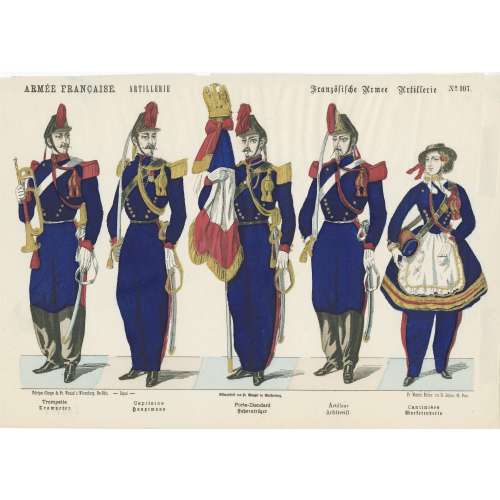 Hand-coloured woodcut on wove paper, 265 x 378 mm; black ink stamp “5051 1” to reverse. Top left: "ARMÉE FRANCAISE. ARTILLERIE"; right: (gothic font) "Französische Armee Artillerie" — "№ 107". Below left: "Fabrique d’Images de Fr. Wentzel à Wissembeurg. Bas-Rhin." — "Déposé" —, centre: "Bilderfabrit von Fr. Wentzel in Weissenburg", right: "Fr. Wentzel, Éditeur, rue St. Jacques, 65, Paris". Bottom: "Trompette | Trompeter" — "Capitaine | Gauptmann" — "Porte-Étendard | Fahnenträger" — "Artilleur | Artillerist" — "Cantinière | Marketenderin". Jean Frédéric Wentzel (French, 1807 – 1869) – publisher/printer.
Hand-coloured woodcut on wove paper, 265 x 378 mm; black ink stamp “5051 1” to reverse. Top left: "ARMÉE FRANCAISE. ARTILLERIE"; right: (gothic font) "Französische Armee Artillerie" — "№ 107". Below left: "Fabrique d’Images de Fr. Wentzel à Wissembeurg. Bas-Rhin." — "Déposé" —, centre: "Bilderfabrit von Fr. Wentzel in Weissenburg", right: "Fr. Wentzel, Éditeur, rue St. Jacques, 65, Paris". Bottom: "Trompette | Trompeter" — "Capitaine | Gauptmann" — "Porte-Étendard | Fahnenträger" — "Artilleur | Artillerist" — "Cantinière | Marketenderin". Jean Frédéric Wentzel (French, 1807 – 1869) – publisher/printer. -
 Fuchi: 38 x 22 x 14 mm. Kashira: 33 x 18 x 9 mm Techniques: Usu-shishiai-bori (薄肉合彫) – low-relief, zogan.
Fuchi: 38 x 22 x 14 mm. Kashira: 33 x 18 x 9 mm Techniques: Usu-shishiai-bori (薄肉合彫) – low-relief, zogan. -
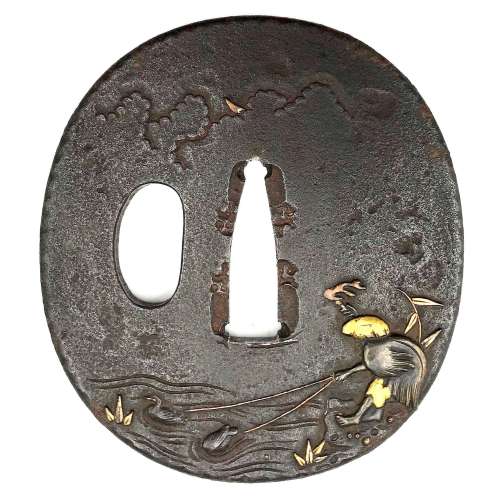 Iron tsuba of oval form carved and inlaid in gold and copper with cormorant fisherman in disguise. Unsigned. Dimensions: 67.7 mm x 61.5 mm x 3.8 mm (at seppa-dai) Edo period: 18th century. "Since Nara period, Japanese fishermen in small boats have used cormorants (u) to catch river fish at night, binding the necks of the birds so that the fish are not swallowed. [...] The bird and the work it performs are symbols of selfless devotion to one's master and keen eyesight." - from Merrily Baird. Symbols of Japan. Thematic motifs in art and design. Rizzoli international publications, Inc., 2001; p. 104. See also TSU-0212 and TSU-0096
Iron tsuba of oval form carved and inlaid in gold and copper with cormorant fisherman in disguise. Unsigned. Dimensions: 67.7 mm x 61.5 mm x 3.8 mm (at seppa-dai) Edo period: 18th century. "Since Nara period, Japanese fishermen in small boats have used cormorants (u) to catch river fish at night, binding the necks of the birds so that the fish are not swallowed. [...] The bird and the work it performs are symbols of selfless devotion to one's master and keen eyesight." - from Merrily Baird. Symbols of Japan. Thematic motifs in art and design. Rizzoli international publications, Inc., 2001; p. 104. See also TSU-0212 and TSU-0096 -
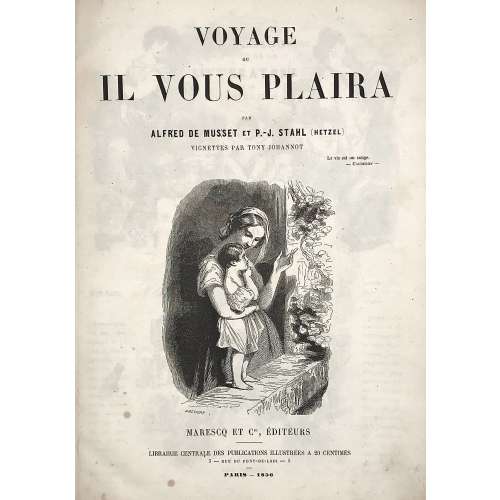
Voyage ou Il vous plaira by Alfred de Musset and P.-J. Stahl (Hetzel); Tony Johannot (illustrations). [Les chefs d'oeuvres de la litterature et de l'illustration] // Marescq et Cie, éditeurs, - Paris, 1856.
Contes de Charles Nodier by Jean Charles Emmanuel Nodier (1780 – 1844) illustrated by H. Émy.
Owner's binding in red half Morocco, A4 (297 x 219 mm). "Voyage ou Il vous plaira" (60 pages) and fairy tales by Charles Nodier with illustrations by H. Émy (Armand-Louis-Henri Telory, born in Strasbourg in 1820 and died in 1874): "La Fée aux miettes" ; "Le songe d'or (fable levantine)"; "La légende de la Soeur Béatrix"; "Trilby"; Inès de las Sierras"; "Baptiste Montauban"; "Smarra ou les démons de la nuit"; "La neuvaine de la Chandeleur"; "La combe de l’homme mort". Extensive foxing, owner's pencil drawings on some pages, otherwise good condition.
-
 Uncut fan print (uchiwa-e) with the design of kabuki actor Nakamura Utaemon IV who held the name of Nakamura Shikan II from the 11th lunar month of 1825 to the 12th lunar month of 1835, dressed in a checkered kimono, holding a pipe and surrounded by flying fireflies. Character: Nakamura Utaemon IV [中村歌右衛門] (Japanese, 1796 – 1852); other names: Nakamura Shikan II, Nakamura Tsurusuke I, Nakamura Tōtarō. Series title: Catching fireflies in the floating world [浮世蛍狩] (Ukiyo hotarugari). Artist: Utagawa Kunisada [歌川 国貞], a.k.a. Toyokuni III (Japanese, 1786 – 1865). Signed: Kōchōrō Kunisada ga [香蝶楼国貞画] in a red cartouche. Publisher: Ibaya Kyubei [伊場屋 久兵衛] (Japanese, fl. 1804 – 1851); seal: modified Marks 19-009 | 126d. Censor's seal: Kiwame Date seal: Tenpō 2 (1831). Ref: Kunisada.de, N58. A look-alike yearlier Kunisada's design can be found at kunisada.de, ref. # N120-Z0172-410:
Uncut fan print (uchiwa-e) with the design of kabuki actor Nakamura Utaemon IV who held the name of Nakamura Shikan II from the 11th lunar month of 1825 to the 12th lunar month of 1835, dressed in a checkered kimono, holding a pipe and surrounded by flying fireflies. Character: Nakamura Utaemon IV [中村歌右衛門] (Japanese, 1796 – 1852); other names: Nakamura Shikan II, Nakamura Tsurusuke I, Nakamura Tōtarō. Series title: Catching fireflies in the floating world [浮世蛍狩] (Ukiyo hotarugari). Artist: Utagawa Kunisada [歌川 国貞], a.k.a. Toyokuni III (Japanese, 1786 – 1865). Signed: Kōchōrō Kunisada ga [香蝶楼国貞画] in a red cartouche. Publisher: Ibaya Kyubei [伊場屋 久兵衛] (Japanese, fl. 1804 – 1851); seal: modified Marks 19-009 | 126d. Censor's seal: Kiwame Date seal: Tenpō 2 (1831). Ref: Kunisada.de, N58. A look-alike yearlier Kunisada's design can be found at kunisada.de, ref. # N120-Z0172-410:
Actor Onoe Baikō, artist Kunisada, publisher Ibaya Kyūbei, c. 1820.
-
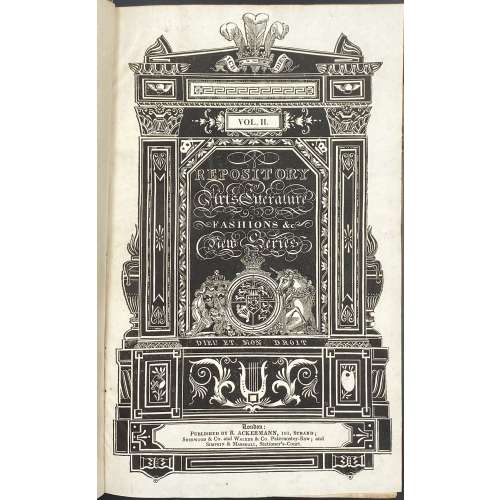 Pagination: [2] – letterpress title / blank, [2] – t.p. contents / to readers, [1] 2-368 [4 index], + 9 b/w and 27 coloured plates. Collation: 4to; letterpress title, [A]1 B-Z4 Aa-Zz4 3A-3B4 3C3. Binding: 25 x 16 cm; gilt-ruled half-calf over marbled boards, flat spine, gilt-ruled compartments, gilt lettering; front board almost detached. References: Martin Hardie (1906), p.310 [LIB-2623.2021]; R. V. Tooley (1935), p. 26 [LIB-2641.2021]; J. R. Abbey (1953), Cat. № 212, p. 166 [LIB-2622.2021].
Pagination: [2] – letterpress title / blank, [2] – t.p. contents / to readers, [1] 2-368 [4 index], + 9 b/w and 27 coloured plates. Collation: 4to; letterpress title, [A]1 B-Z4 Aa-Zz4 3A-3B4 3C3. Binding: 25 x 16 cm; gilt-ruled half-calf over marbled boards, flat spine, gilt-ruled compartments, gilt lettering; front board almost detached. References: Martin Hardie (1906), p.310 [LIB-2623.2021]; R. V. Tooley (1935), p. 26 [LIB-2641.2021]; J. R. Abbey (1953), Cat. № 212, p. 166 [LIB-2622.2021]. -
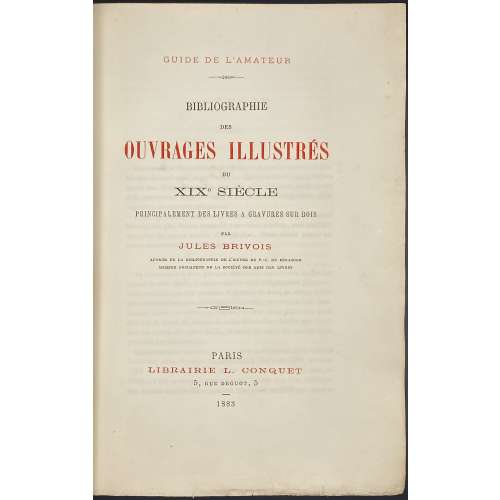 Title page: GUIDE DE L’AMATEUR | BIBLIOGRAPHIE | DES | OUVRAGES ILLUSTRES | DU | XIXe SIÈCLE | PRINCIPALEMENT DES LIVRES A GRAVURES SUR BOIS | PAR | JULES BRIVOIS | AUTEUR DE LA BIBLIOGRAPHIE DE L’ŒUVRE DE P.-J. BÉRANGER | MEMBRE FONDATEUR DE LA SOCIÉTÉ DES AMIS DES LIVRES | — | PARIS | LIBRAIRIE L. CONQUET | 5, RUE DROUOT, 5 | 1883 || Justification: Il a été tire : | 900 exemplaires sur papier vergé. | Et 50 exemplaires sur grand papier de Hollande. | Tous sont numérotés et paraphes par l’auteur. | № {188 signature} | Les numéros pairs portent le nom de M. L. Conquet. | Et les numéros impairs celui de M. P. Rouquette. | — | Le dépôt légal sera fait en France et dans tous les pays avec lesquels il | existe des conventions pour la propriété littéraire. | Tous droits réservés. || Pagination : [2] blank, [i-v] vi-xiii [xiv], [1] 2-468; the total number of pages = 484. Collation: π8 1-288 2910, an asterisk on leaf 295; the total number of leaves 242; 3 blank leaves of wove paper before and after collation. Imprint to 11 : Imp. de Mme de Lacombe; Imprint to 2910 : Nancy, imprimerie Berger-Levrault et Cie. Binding: ¾ polished distressed calf over marbled boards by the previous owner "E.D", gilt-stamped spine with gilt-lettered black label, peacock marbled endpapers, printed on laid paper. Contributors: Jules Brivois (French, 1832 – 1920) – author. L. Conquet (Paris) – publisher. P. Rouquette (Paris) – publisher. Berger-Levrault et Cie – printer.
Title page: GUIDE DE L’AMATEUR | BIBLIOGRAPHIE | DES | OUVRAGES ILLUSTRES | DU | XIXe SIÈCLE | PRINCIPALEMENT DES LIVRES A GRAVURES SUR BOIS | PAR | JULES BRIVOIS | AUTEUR DE LA BIBLIOGRAPHIE DE L’ŒUVRE DE P.-J. BÉRANGER | MEMBRE FONDATEUR DE LA SOCIÉTÉ DES AMIS DES LIVRES | — | PARIS | LIBRAIRIE L. CONQUET | 5, RUE DROUOT, 5 | 1883 || Justification: Il a été tire : | 900 exemplaires sur papier vergé. | Et 50 exemplaires sur grand papier de Hollande. | Tous sont numérotés et paraphes par l’auteur. | № {188 signature} | Les numéros pairs portent le nom de M. L. Conquet. | Et les numéros impairs celui de M. P. Rouquette. | — | Le dépôt légal sera fait en France et dans tous les pays avec lesquels il | existe des conventions pour la propriété littéraire. | Tous droits réservés. || Pagination : [2] blank, [i-v] vi-xiii [xiv], [1] 2-468; the total number of pages = 484. Collation: π8 1-288 2910, an asterisk on leaf 295; the total number of leaves 242; 3 blank leaves of wove paper before and after collation. Imprint to 11 : Imp. de Mme de Lacombe; Imprint to 2910 : Nancy, imprimerie Berger-Levrault et Cie. Binding: ¾ polished distressed calf over marbled boards by the previous owner "E.D", gilt-stamped spine with gilt-lettered black label, peacock marbled endpapers, printed on laid paper. Contributors: Jules Brivois (French, 1832 – 1920) – author. L. Conquet (Paris) – publisher. P. Rouquette (Paris) – publisher. Berger-Levrault et Cie – printer. -

Two images printed on one sheet of van Gelder wove paper. Owner's stamp 'LvM' on verso.
Dimensions: Paper: 46.7 x 31 cm; top Mon bourgmestre: 11 x 9 cm plate, 9 x 7.5 cm image; Bottom Le modèle: 13.5 x 8.5 cm plate, 10 x 7 cm image.
Catalogue raisonné: Arthur Hubschmid (1977): 341 & 342; Rouir 425:4 & 517:7.
-
 Artist: Utagawa Kunisada [歌川 国貞] a.k.a. Utagawa Toyokuni III [三代歌川豊国] (Japanese, 1786 – 1865). Artists signature: Kunisada ga [国貞画] in a red double-gourd cartouche. Character: Kabuki actor Ichikawa Danjūrō VII [七代目 市川 團十郎]; other names: Ichikawa Ebizō V, Ichikawa Shinnosuke I (Japanese, 1791 – 1859). Series: Six choice modern flowers [當世六花撰] (Tosei rok’kasen). No publisher's seal, no date or censor's seal is present. Size: Fan print (aiban uchiwa-e); 232 x 289 mm. Provenance: Paul F. Walter. Izzard: "... six prints make up this set of fan prints, which compares contemporary artists with classic poets, in this case, Ichikawa Danjūrō VII with Ōtomo no Kuronushi [大友 黒主] (Japanese, dates unknown)". Rok'kasen [六歌仙] – six poetry immortals. According to Izzard, identification of the portrayed person is made possible by mimasu-mon [三升] on the robe, scrolling peony on the back of the mirror, and cloth decorated with the characters Yauan, one of the actor's poetry names, and other signs and symbols, including the inscription of the acter's guild name Naritaya. The absence of the publisher’s emblem and censorship seals may indicate that this was a privately issued print, not for public use. Ref: (1) [LIB-2967.2022] Utagawa Kunisada (1786 – 1865): His world revisited / Catalogue № 17, Exhibition March 17-21, 2021. — NY: Sebastian Izzard, LLC., 2021; p. 130-1, fig. 42). (2) Lyon Collection. Mimasu-mon, or Mitsumasu, is the Ichikawa Danjūrō family crest – three wooden measures, nested square boxes.
Artist: Utagawa Kunisada [歌川 国貞] a.k.a. Utagawa Toyokuni III [三代歌川豊国] (Japanese, 1786 – 1865). Artists signature: Kunisada ga [国貞画] in a red double-gourd cartouche. Character: Kabuki actor Ichikawa Danjūrō VII [七代目 市川 團十郎]; other names: Ichikawa Ebizō V, Ichikawa Shinnosuke I (Japanese, 1791 – 1859). Series: Six choice modern flowers [當世六花撰] (Tosei rok’kasen). No publisher's seal, no date or censor's seal is present. Size: Fan print (aiban uchiwa-e); 232 x 289 mm. Provenance: Paul F. Walter. Izzard: "... six prints make up this set of fan prints, which compares contemporary artists with classic poets, in this case, Ichikawa Danjūrō VII with Ōtomo no Kuronushi [大友 黒主] (Japanese, dates unknown)". Rok'kasen [六歌仙] – six poetry immortals. According to Izzard, identification of the portrayed person is made possible by mimasu-mon [三升] on the robe, scrolling peony on the back of the mirror, and cloth decorated with the characters Yauan, one of the actor's poetry names, and other signs and symbols, including the inscription of the acter's guild name Naritaya. The absence of the publisher’s emblem and censorship seals may indicate that this was a privately issued print, not for public use. Ref: (1) [LIB-2967.2022] Utagawa Kunisada (1786 – 1865): His world revisited / Catalogue № 17, Exhibition March 17-21, 2021. — NY: Sebastian Izzard, LLC., 2021; p. 130-1, fig. 42). (2) Lyon Collection. Mimasu-mon, or Mitsumasu, is the Ichikawa Danjūrō family crest – three wooden measures, nested square boxes.
-
 Utagawa Kunisada [歌川 国貞] a.k.a. Utagawa Toyokuni III [三代歌川豊国] (Japanese, 1786 – 1865). Signed: Toyokuni ga [豊国 画] in a yellow toshidama cartouche. Publisher: Unknown, seal [久] Kyū (Japanese, fl. c. 1851 – 1861); (Marks 07-023 | U176a, possibly Sagamia Kyūzō). Block carver: Koizumi Minokichi [小泉巳の吉] (Japanese, 1833 – 1906); seal: Hori Mino [彫已の] (Gordon Friese № 38). Date seal and double nanushi censor seals: Fuku & Muramatsu, Kaei 6, 2nd month (2/1853). Inscription in a red cartouche: (Purple of Edo // Purple of the Bay Capital) [江都むらさき] (Edo Murasaki), alluding to Murasaki Shikibu [紫 式部] (Japanese, c. 973/8 – c. 1014/31), the author of Genji Monogatari [源氏物語] (The Tale of Genji), a Heian period novel which was the source of a parody Nise Murasaki Inaka Genji [偐紫田舎源氏] (Fake Murasaki’s Rustic Genji) by Ryutei Tanehiko [柳亭種彦] (Japanese, 1783 – 1842). According to Horst Graebner: The actor is most probably Segawa Kikunojō V. Segawa Kikunojō V [瀬川菊之丞] (Japanese, 1802 – 1832); other names: Segawa Tamon I. One of the series of Kunisada's fan prints in this collection:
Utagawa Kunisada [歌川 国貞] a.k.a. Utagawa Toyokuni III [三代歌川豊国] (Japanese, 1786 – 1865). Signed: Toyokuni ga [豊国 画] in a yellow toshidama cartouche. Publisher: Unknown, seal [久] Kyū (Japanese, fl. c. 1851 – 1861); (Marks 07-023 | U176a, possibly Sagamia Kyūzō). Block carver: Koizumi Minokichi [小泉巳の吉] (Japanese, 1833 – 1906); seal: Hori Mino [彫已の] (Gordon Friese № 38). Date seal and double nanushi censor seals: Fuku & Muramatsu, Kaei 6, 2nd month (2/1853). Inscription in a red cartouche: (Purple of Edo // Purple of the Bay Capital) [江都むらさき] (Edo Murasaki), alluding to Murasaki Shikibu [紫 式部] (Japanese, c. 973/8 – c. 1014/31), the author of Genji Monogatari [源氏物語] (The Tale of Genji), a Heian period novel which was the source of a parody Nise Murasaki Inaka Genji [偐紫田舎源氏] (Fake Murasaki’s Rustic Genji) by Ryutei Tanehiko [柳亭種彦] (Japanese, 1783 – 1842). According to Horst Graebner: The actor is most probably Segawa Kikunojō V. Segawa Kikunojō V [瀬川菊之丞] (Japanese, 1802 – 1832); other names: Segawa Tamon I. One of the series of Kunisada's fan prints in this collection: -
 Artist: Utagawa Kunisada [歌川 国貞] a.k.a. Utagawa Toyokuni III [三代歌川豊国] (Japanese, 1786 – 1865). No publisher seal, no date or censor seal; probably a private printing. Signed: Kunisada ga [国貞画] in a red double gourd cartouche. Media: Untrimmed fan print (uchiwa-e), 231 x 294 mm, with the use of mica and black lacquer.
Artist: Utagawa Kunisada [歌川 国貞] a.k.a. Utagawa Toyokuni III [三代歌川豊国] (Japanese, 1786 – 1865). No publisher seal, no date or censor seal; probably a private printing. Signed: Kunisada ga [国貞画] in a red double gourd cartouche. Media: Untrimmed fan print (uchiwa-e), 231 x 294 mm, with the use of mica and black lacquer. -
 Artist: Utagawa Kunisada [歌川 国貞], a.k.a. Utagawa Toyokuni III [三代 歌川 豊国] (Japanese, 1786 – 1865). Signed: Toyokuni ga [豊国 画] in a red toshidama cartouche Block carver: Yokokawa Takejirō [横川竹二郎] (Japanese, fl. 1845 – 1863), seal: 彫竹 – hori Take. Publisher: Ibaya Senzaburō [伊場屋仙三郎] (Japanese, fl. c. 1845 – 1847). Media: Untrimmed fan print (uchiwa-e), 238 x 304 mm. Title: Saiko (West River) [西江]; 西江 means the Xi River in China. Series: Chronicles of Elegant Women [風雅女史傳] (Fūga joshiden). Combined date seal and kiwame censor seal: Ansei 6 (1859). Other prints from the same series in this collection: SVJP-0216.2016 — Princess Sotoori:
Artist: Utagawa Kunisada [歌川 国貞], a.k.a. Utagawa Toyokuni III [三代 歌川 豊国] (Japanese, 1786 – 1865). Signed: Toyokuni ga [豊国 画] in a red toshidama cartouche Block carver: Yokokawa Takejirō [横川竹二郎] (Japanese, fl. 1845 – 1863), seal: 彫竹 – hori Take. Publisher: Ibaya Senzaburō [伊場屋仙三郎] (Japanese, fl. c. 1845 – 1847). Media: Untrimmed fan print (uchiwa-e), 238 x 304 mm. Title: Saiko (West River) [西江]; 西江 means the Xi River in China. Series: Chronicles of Elegant Women [風雅女史傳] (Fūga joshiden). Combined date seal and kiwame censor seal: Ansei 6 (1859). Other prints from the same series in this collection: SVJP-0216.2016 — Princess Sotoori:

-
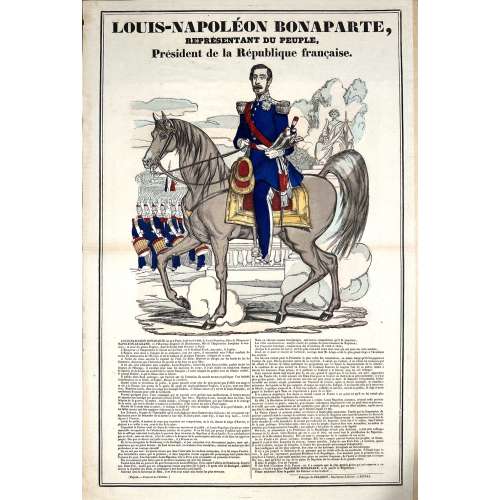 Hand-coloured woodcut poster on wove paper, 622 x 417 mm; black ink stamp “4859” to reverse, horizontal centrefold. In a double frame, top: LOUIS-NAPOLÉON BONAPARTE, | REPRÉSENTANT DU PEUPLE, | Président de la République française. Text under the image ; bottom left: (Déposé.— Propriété de l’Éditeur.); right: Fabrique de PELLERIN, Imprimeur-Libraire, à ÉPINAL. Jean Charles Pellerin (French, 1756 – 1836) – printer/publisher.
Hand-coloured woodcut poster on wove paper, 622 x 417 mm; black ink stamp “4859” to reverse, horizontal centrefold. In a double frame, top: LOUIS-NAPOLÉON BONAPARTE, | REPRÉSENTANT DU PEUPLE, | Président de la République française. Text under the image ; bottom left: (Déposé.— Propriété de l’Éditeur.); right: Fabrique de PELLERIN, Imprimeur-Libraire, à ÉPINAL. Jean Charles Pellerin (French, 1756 – 1836) – printer/publisher.








